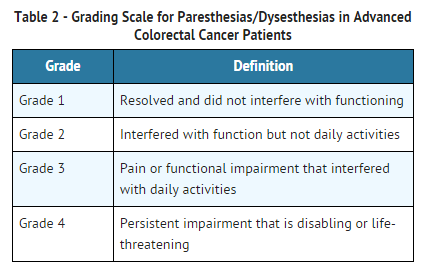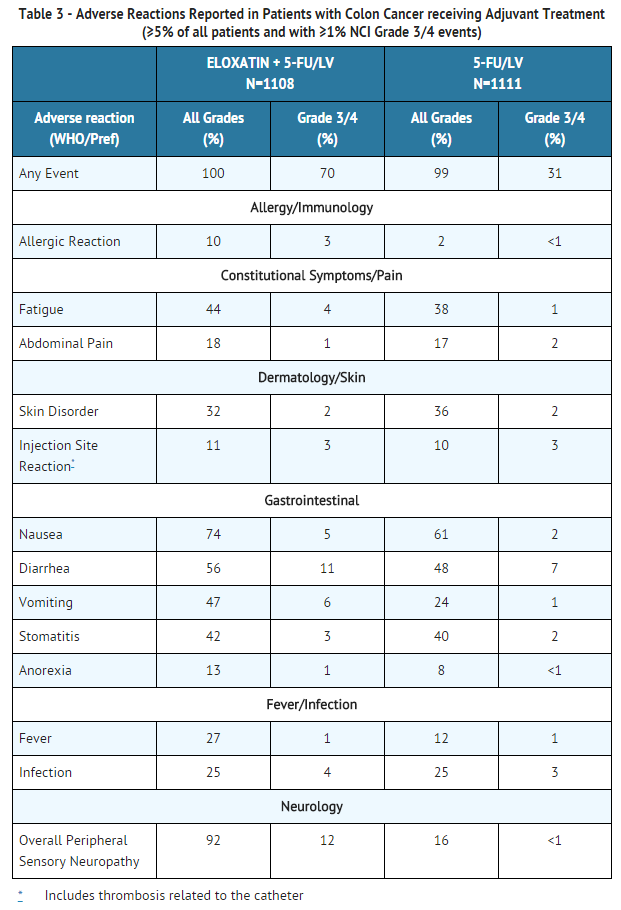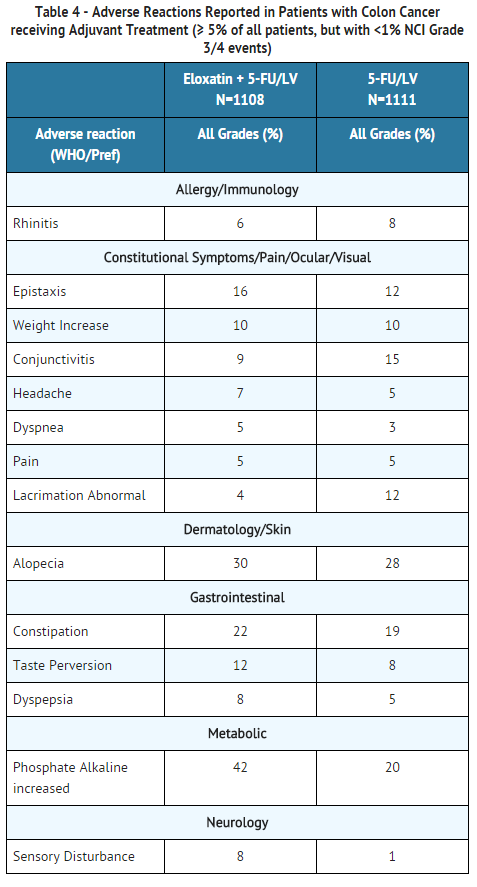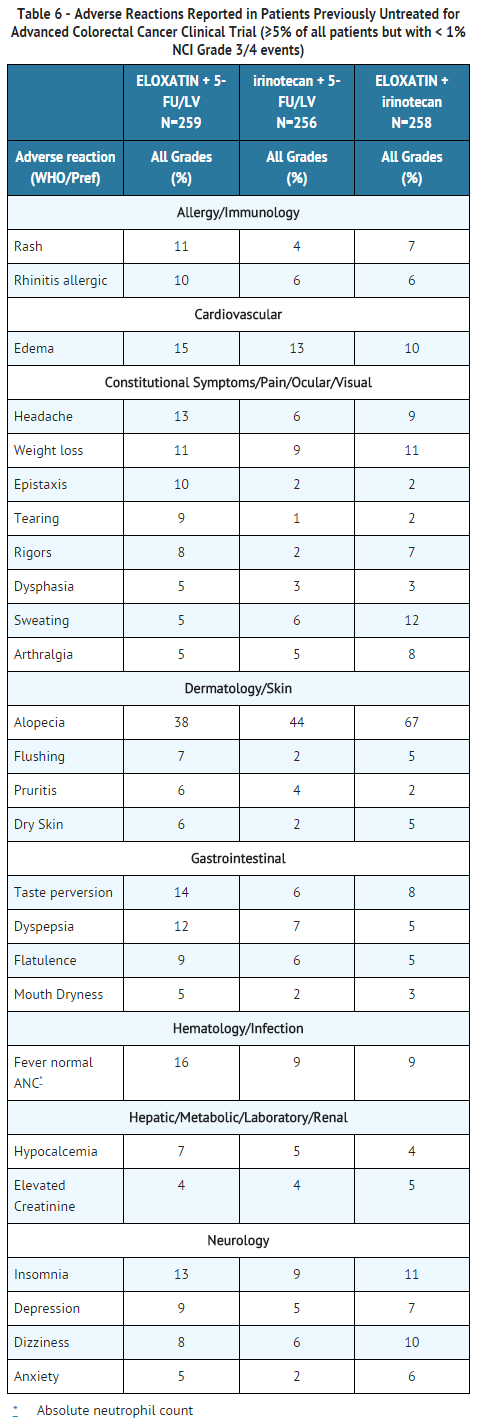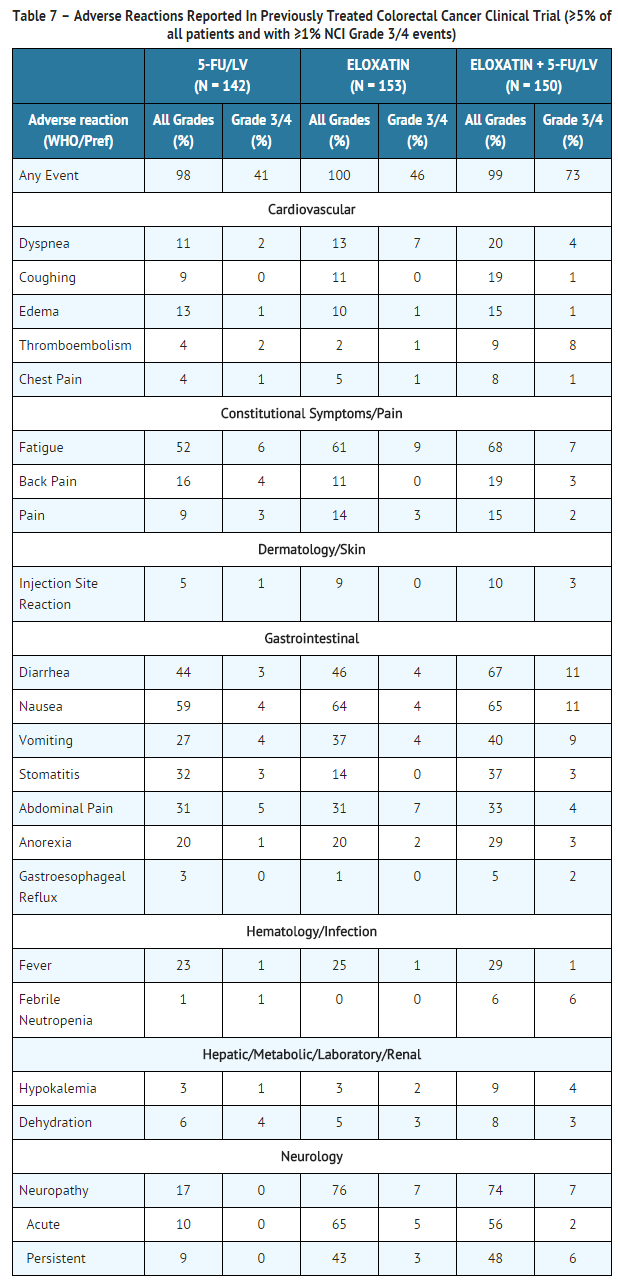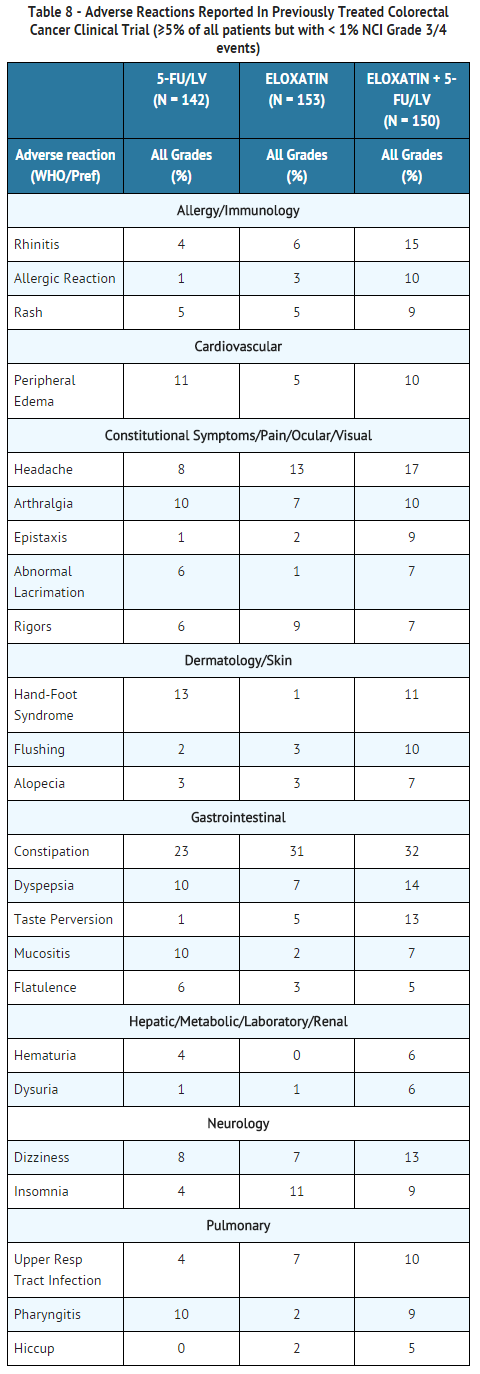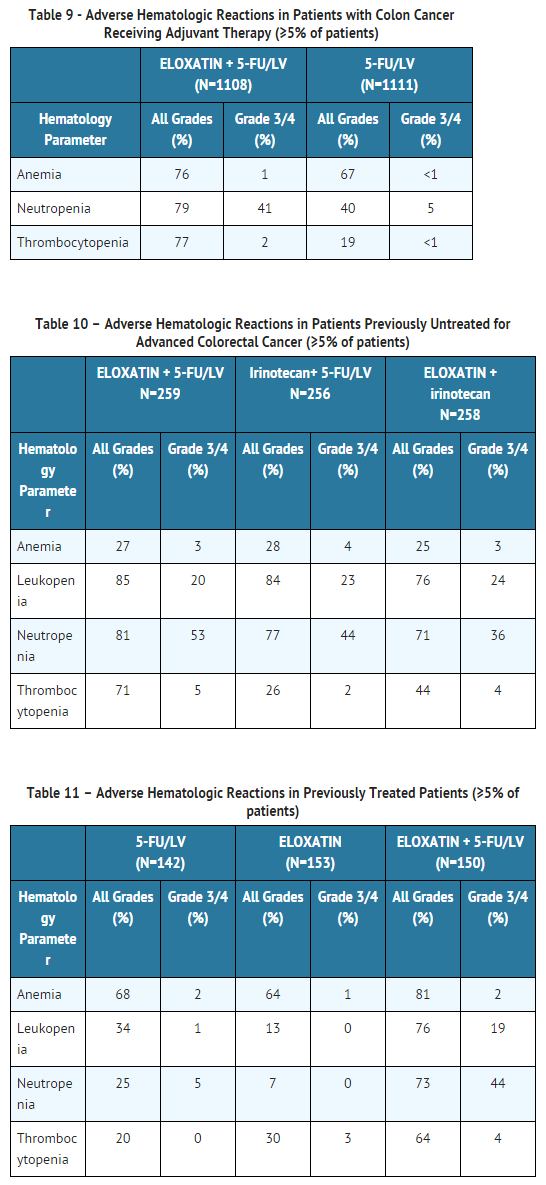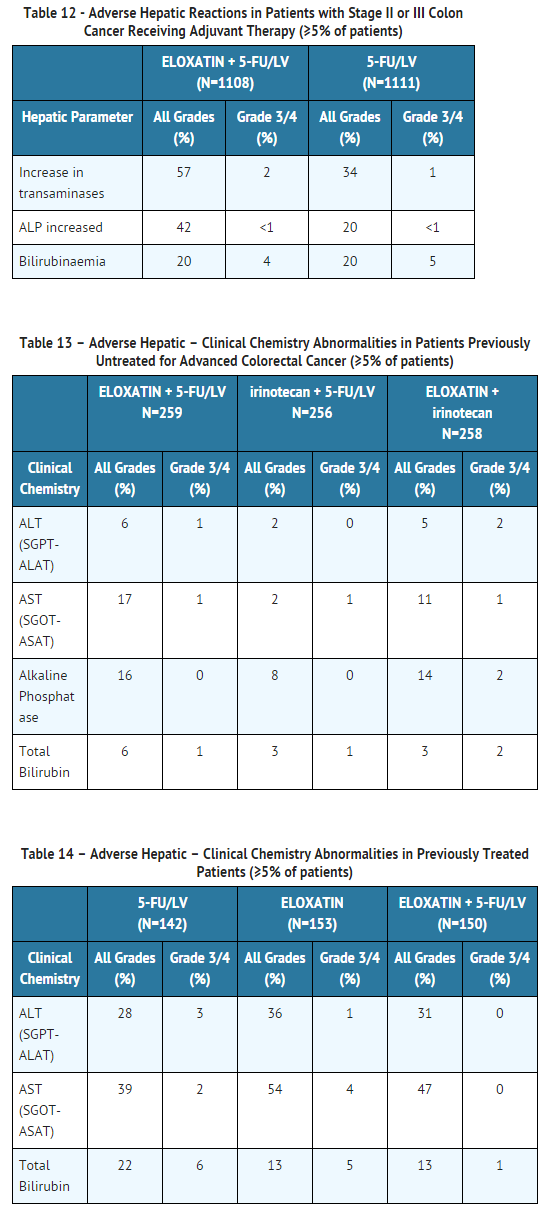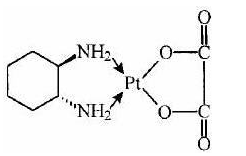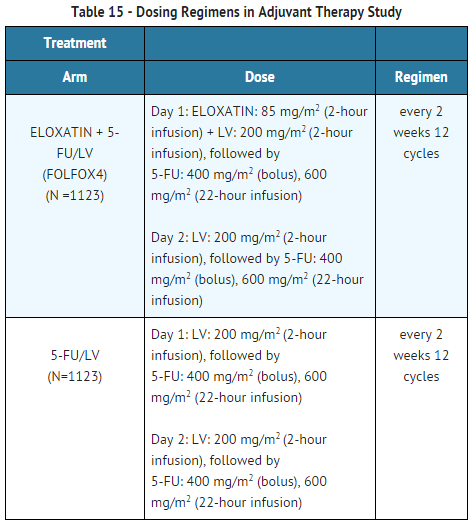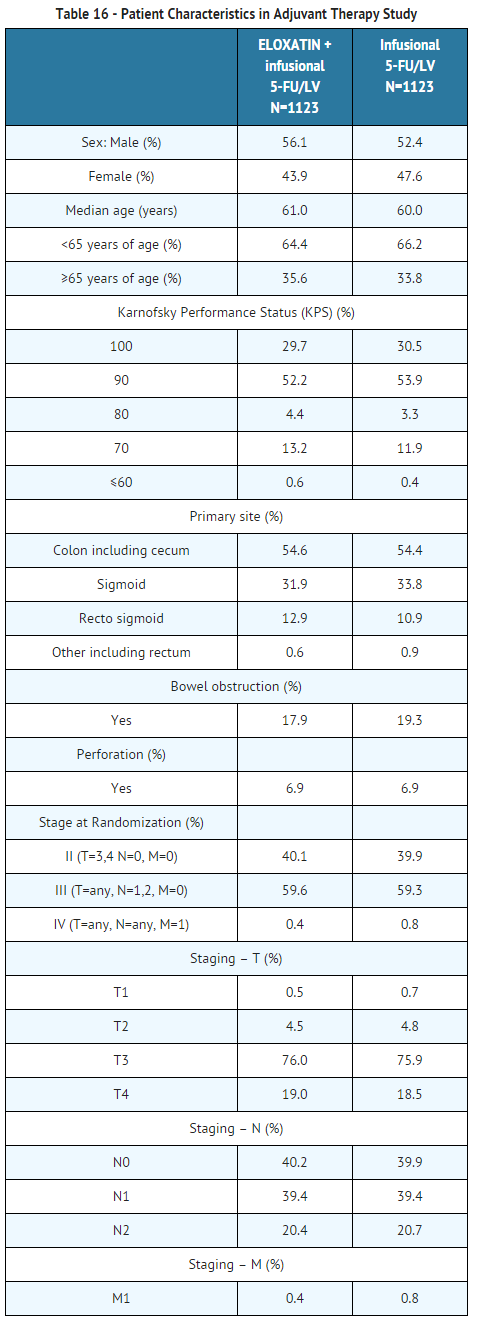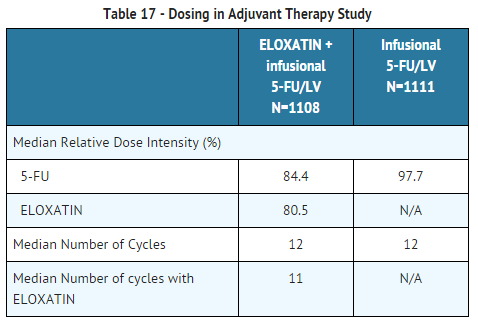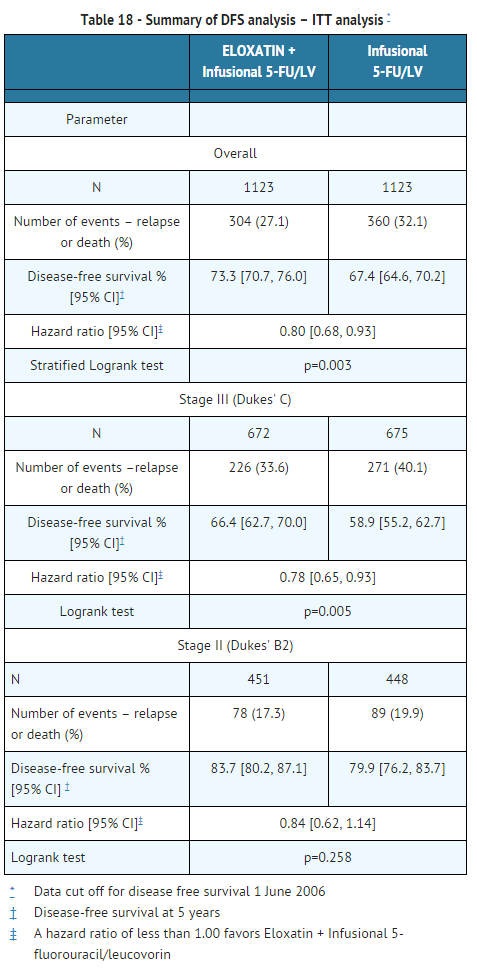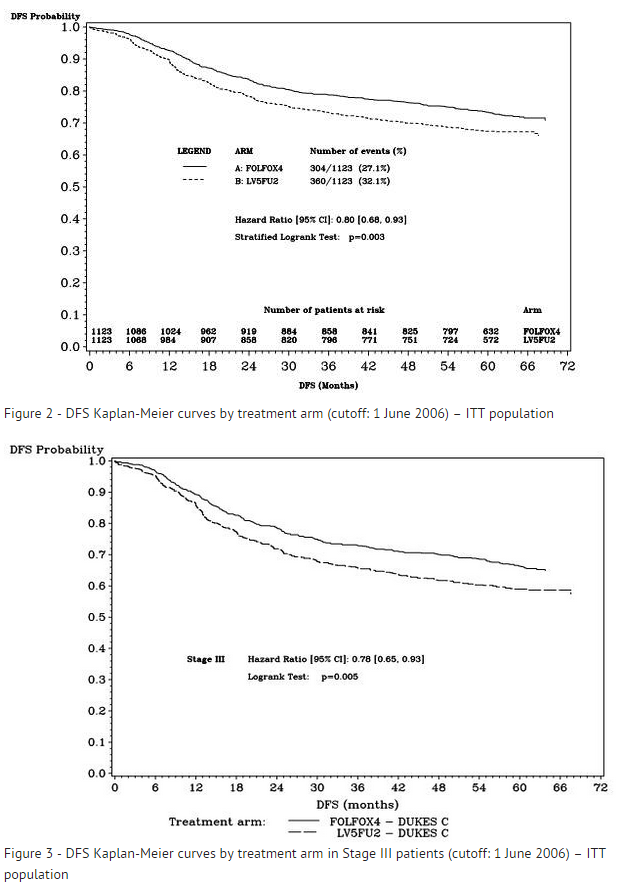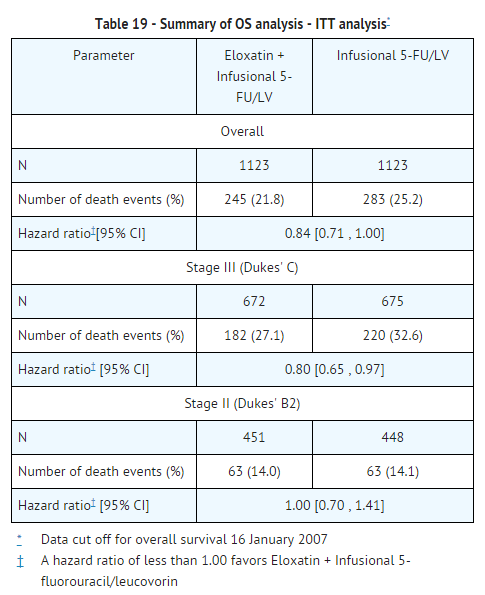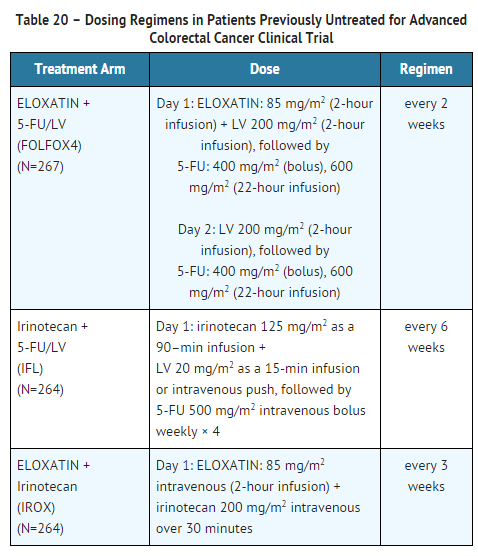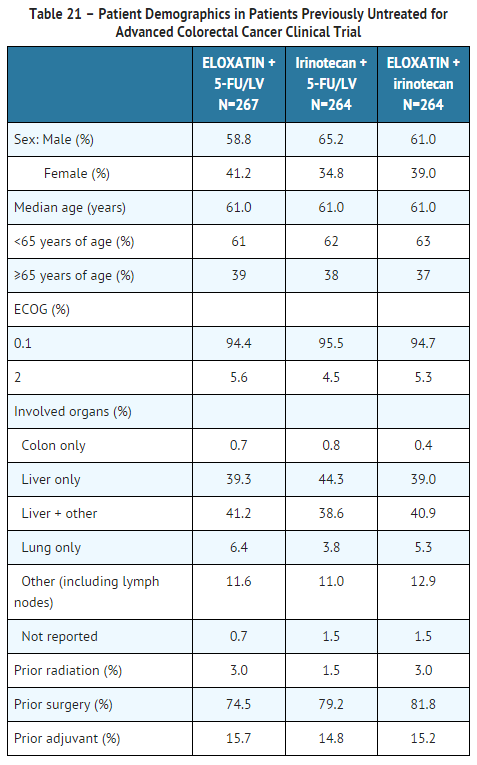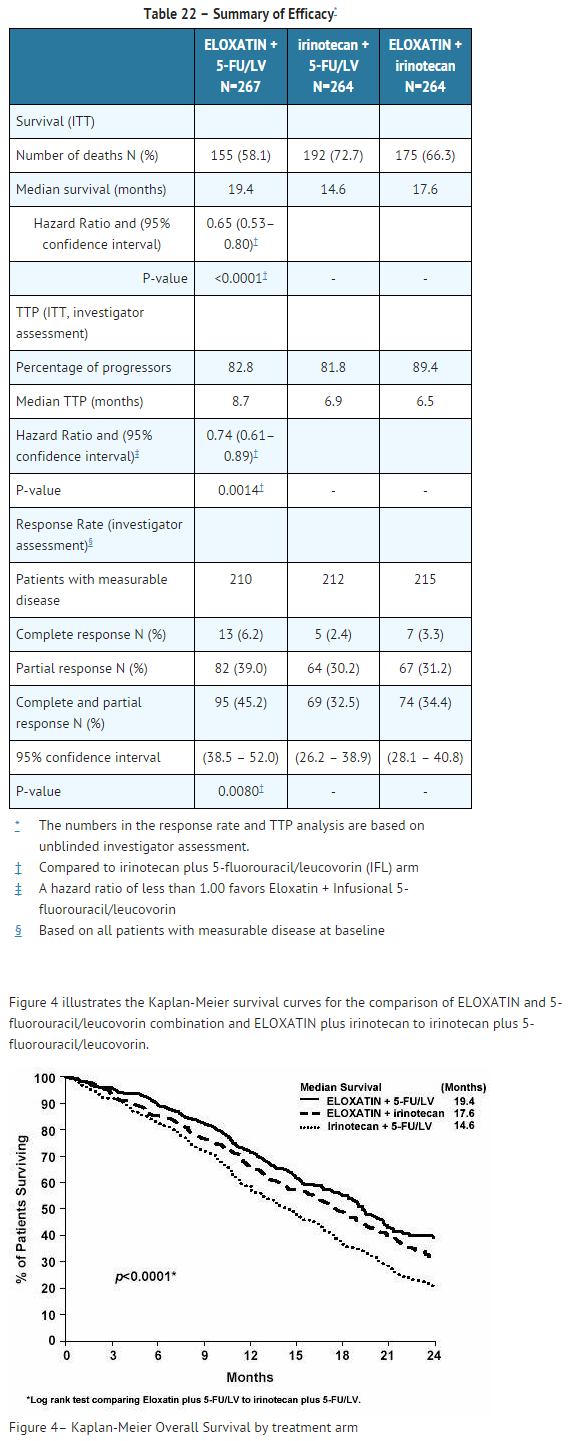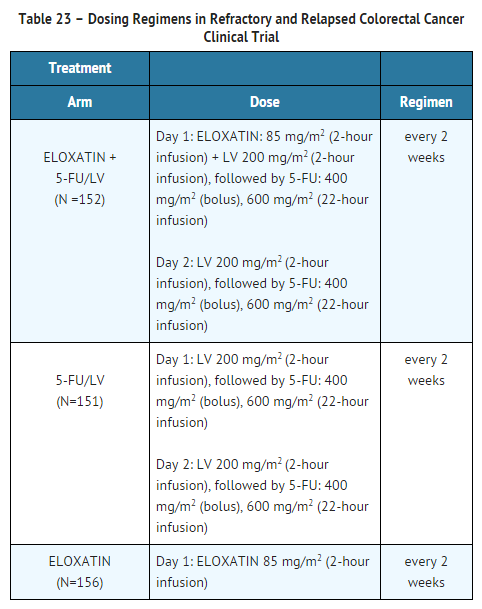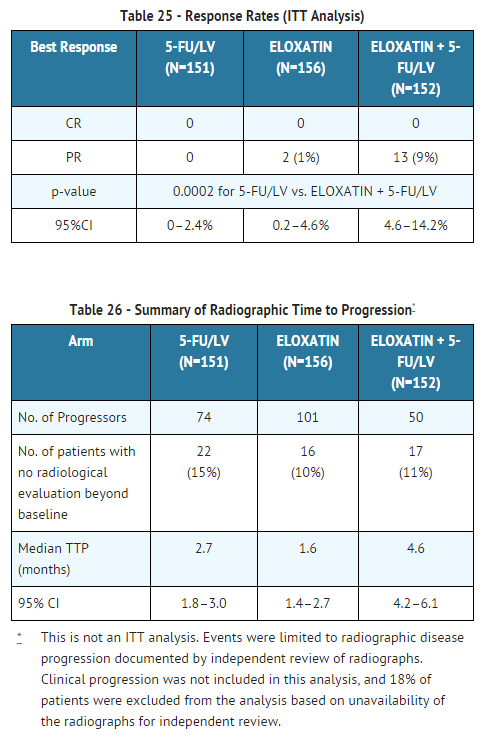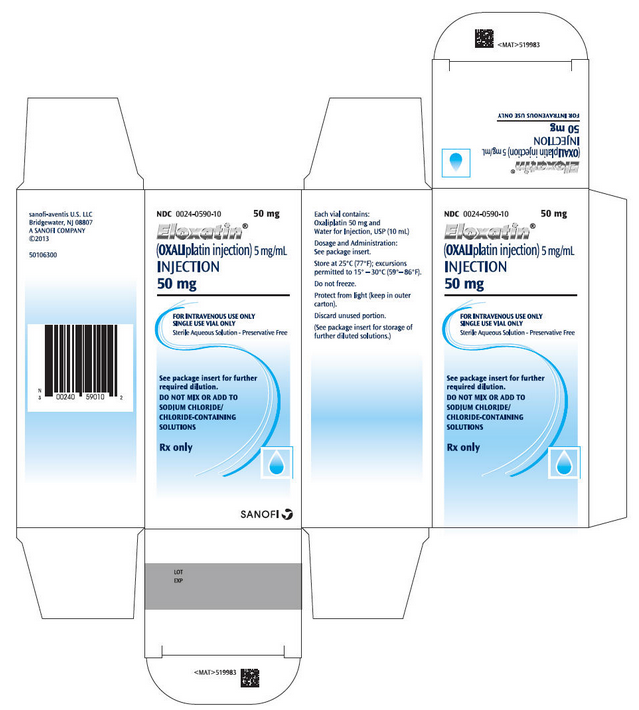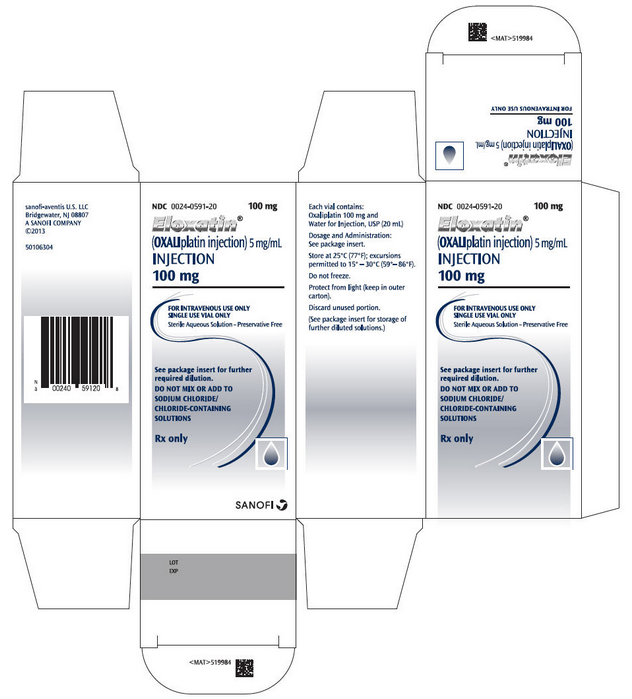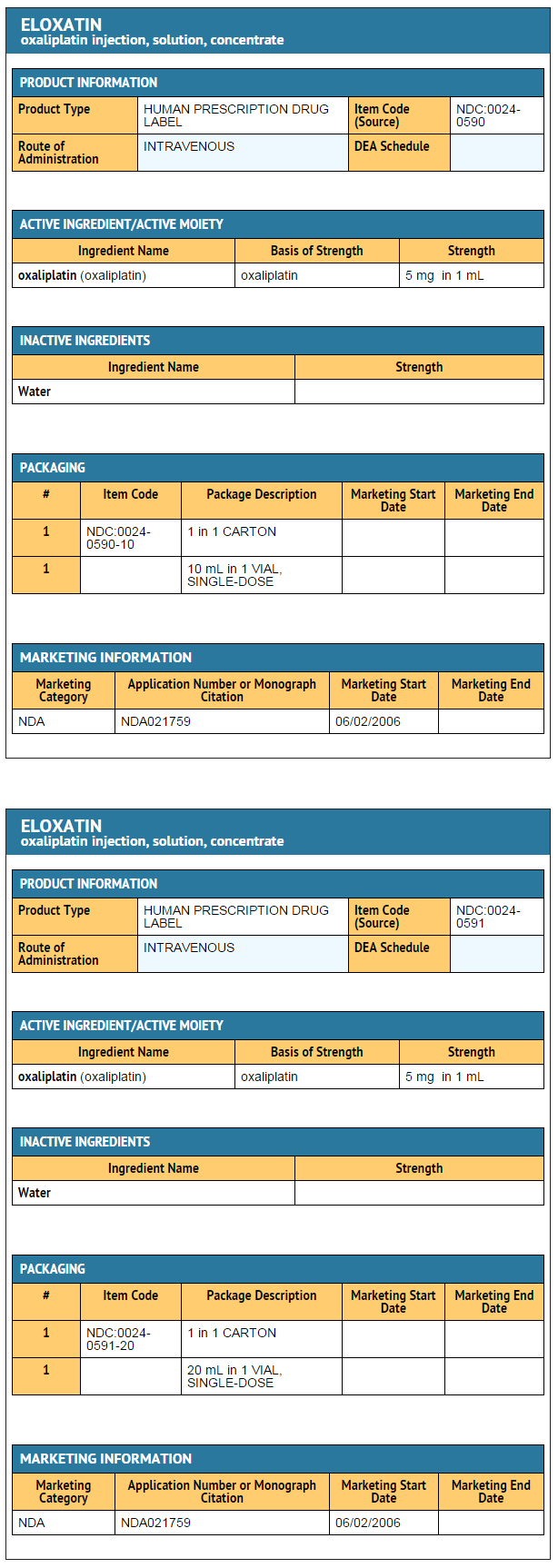Oxaliplatin
Editor-In-Chief: C. Michael Gibson, M.S., M.D. [1]; Associate Editor(s)-in-Chief: Rabin Bista, M.B.B.S. [2]
Disclaimer
WikiDoc MAKES NO GUARANTEE OF VALIDITY. WikiDoc is not a professional health care provider, nor is it a suitable replacement for a licensed healthcare provider. WikiDoc is intended to be an educational tool, not a tool for any form of healthcare delivery. The educational content on WikiDoc drug pages is based upon the FDA package insert, National Library of Medicine content and practice guidelines / consensus statements. WikiDoc does not promote the administration of any medication or device that is not consistent with its labeling. Please read our full disclaimer here.
Black Box Warning
|
WARNING: ANAPHYLACTIC REACTIONS:
See full prescribing information for complete Boxed Warning.
* Anaphylactic reactions to Oxaliplatin have been reported, and may occur within minutes of Oxaliplatin administration. Epinephrine, corticosteroids, and antihistamines have been employed to alleviate symptoms.
|
Overview
Oxaliplatin is an Antineoplastic agent and platinum coordination complex that is FDA approved for the treatment of stage III colon cancer in patients who have undergone complete resection of the primary tumor, advanced colorectal cancer. There is a Black Box Warning for this drug as shown here. Common adverse reactions include peripheral sensory neuropathy, neutropenia, thrombocytopenia, anemia, nausea, increase in transaminases and alkaline phosphatase, diarrhea, emesis, fatigue and stomatitis.
Adult Indications and Dosage
FDA-Labeled Indications and Dosage (Adult)
Indications
- Oxaliplatin, used in combination with infusional 5-fluorouracil/Leucovorin, is indicated for:
- adjuvant treatment of stage III colon cancer in patients who have undergone complete resection of the primary tumor.
- treatment of Colorectal canceradvanced colorectal cancer.
Dosage
- Administer Oxaliplatin in combination with 5-fluorouracil/Leucovorin every 2 weeks. For advanced disease, treatment is recommended until disease progression or unacceptable toxicity. For adjuvant use, treatment is recommended for a total of 6 months (12 cycles):
- Day 1: Oxaliplatin 85 mg/m2 intravenous infusion in 250–500 mL 5% Dextrose injection, USP and Leucovorin 200 mg/m2 intravenous infusion in 5% Dextrose Injection, USP both given over 120 minutes at the same time in separate bags using a Y-line, followed by 5-fluorouracil 400 mg/m2 intravenous bolus given over 2–4 minutes, followed by 5-fluorouracil 600 mg/m2 intravenous infusion in 500 mL 5% Dextrose Injection, USP (recommended) as a 22-hour continuous infusion.
- Day 2: Leucovorin 200 mg/m2 intravenous infusion over 120 minutes, followed by 5-fluorouracil 400 mg/m2 intravenous bolus given over 2–4 minutes, followed by 5-fluorouracil 600 mg/m2 intravenous infusion in 500 mL 5% Dextrose Injection, USP (recommended) as a 22-hour continuous infusion.
- The administration of Oxaliplatin does not require prehydration. Premedication with antiemetics, including 5-HT3 blockers with or without dexamethasone, is recommended.
- For information on 5-fluorouracil and Leucovorin, see the respective package inserts.
Dose Modification Recommendations
- Prior to subsequent therapy cycles, patients should be evaluated for clinical toxicities and recommended laboratory test. Prolongation of infusion time for Oxaliplatin from 2 hours to 6 hours may mitigate acute toxicities. The infusion times for 5-fluorouracil and Leucovorin do not need to be changed.
Adjuvant Therapy in Patients with Stage III Colon Cancer
- Neuropathy and other toxicities were graded using the NCI CTC scale version 1.
- For patients who experience persistent Grade 2 neurosensory events that do not resolve, a dose reduction of Oxaliplatin to 75 mg/m2 should be considered. For patients with persistent Grade 3 neurosensory events, discontinuing therapy should be considered. The infusional 5-fluorouracil/Leucovorin regimen need not be altered.
- A dose reduction of Oxaliplatin to 75 mg/m2 and infusional 5-fluorouracil to 300 mg/m2 bolus and 500 mg/m2 22 hour infusion is recommended for patients after recovery from grade 3/4 gastrointestinal (despite prophylactic treatment) or grade 4 neutropenia or grade 3/4 thrombocytopenia. The next dose should be delayed until: neutrophils ≥1.5 × 109/L and platelets ≥75 × 109/L.
- Dose Modifications in Therapy in Previously Untreated and Previously Treated Patients with Advanced Colorectal Cancer
- Neuropathy was graded using a study-specific neurotoxicity scale. Other toxicities were graded by the NCI CTC, Version 2.0.
- For patients who experience persistent Grade 2 neurosensory events that do not resolve, a dose reduction of Oxaliplatin to 65 mg/m2 should be considered. For patients with persistent Grade 3 neurosensory events, discontinuing therapy should be considered. The 5-fluorouracil/Leucovorin regimen need not be altered.
- A dose reduction of Oxaliplatin to 65 mg/m2 and 5-fluorouracil by 20% (300 mg/m2 bolus and 500 mg/m2 22-hour infusion) is recommended for patients after recovery from grade 3/4 gastrointestinal (despite prophylactic treatment) or grade 4 neutropenia or grade 3/4 thrombocytopenia. The next dose should be delayed until: neutrophils ≥1.5 × 109/L and platelets ≥75 × 109/L.
- Dose Modifications in Therapy for Patients with Renal Impairment
- In patients with normal renal function or mild to moderate renal impairment, the recommended dose of Oxaliplatin is 85 mg/m2. In patients with severe renal impairment, the initial recommended Oxaliplatin dose should be reduced to 65 mg/m2.
Preparation of Infusion Solution
- Do not freeze and protect from light the concentrated solution.
A final dilution must never be performed with a sodium chloride solution or other chloride-containing solutions.
- The solution must be further diluted in an infusion solution of 250-500 mL of 5% Dextrose Injection, USP.
- After dilution with 250-500 mL of 5% Dextrose Injection, USP, the shelf life is 6 hours at room temperature [20-25°C (68-77°F)] or up to 24 hours under refrigeration [2-8°C (36-46°F)].
- After final dilution, protection from light is not required.
- Oxaliplatin is incompatible in solution with alkaline medications or media (such as basic solutions of 5-fluorouracil) and must not be mixed with these or administered simultaneously through the same infusion line. The infusion line should be flushed with 5% Dextrose Injection, USP prior to administration of any concomitant medication.
- Parenteral drug products should be inspected visually for particulate matter and discoloration prior to administration and discarded if present.
- Needles or intravenous administration sets containing aluminum parts that may come in contact with Oxaliplatin should not be used for the preparation or mixing of the drug. Aluminum has been reported to cause degradation of platinum compounds.
DOSAGE FORMS AND STRENGTHS
- Oxaliplatin is supplied in single-use vials containing 50 mg or 100 mg of oxaliplatin as a sterile, preservative-free, aqueous solution at a concentration of 5 mg/mL.
Off-Label Use and Dosage (Adult)
Guideline-Supported Use
There is limited information regarding Off-Label Guideline-Supported Use of Oxaliplatin in adult patients.
Non–Guideline-Supported Use
Pediatric Indications and Dosage
FDA-Labeled Indications and Dosage (Pediatric)
There is limited information regarding FDA-Labeled Use of Oxaliplatin in pediatric patients.
Off-Label Use and Dosage (Pediatric)
Guideline-Supported Use
There is limited information regarding Off-Label Guideline-Supported Use of Oxaliplatin in pediatric patients.
Non–Guideline-Supported Use
There is limited information regarding Off-Label Non–Guideline-Supported Use of Oxaliplatin in pediatric patients.
Contraindications
- Oxaliplatin should not be administered to patients with a history of known allergy to Oxaliplatin or other platinum compounds
Warnings
|
WARNING: ANAPHYLACTIC REACTIONS:
See full prescribing information for complete Boxed Warning.
* Anaphylactic reactions to Oxaliplatin have been reported, and may occur within minutes of Oxaliplatin administration. Epinephrine, corticosteroids, and antihistamines have been employed to alleviate symptoms.
|
Allergic Reactions
- Grade 3/4 hypersensitivity, including anaphylactic/anaphylactoid reactions, to Oxaliplatin has been observed in 2–3% of colon cancer patients. These allergic reactions which can be fatal, can occur within minutes of administration and at any cycle, and were similar in nature and severity to those reported with other platinum-containing compounds, such as rash, urticaria, erythema, pruritus, and, rarely, bronchospasm and hypotension. The symptoms associated with hypersensitivity reactions reported in the previously untreated patients were urticaria, pruritus, flushing of the face, diarrhea associated with oxaliplatin infusion, shortness of breath, bronchospasm, diaphoresis, chest pains, hypotension, disorientation and syncope. These reactions are usually managed with standard epinephrine, corticosteroid, antihistamine therapy, and require discontinuation of therapy. Rechallenge is contraindicated in these patients. Drug-related deaths associated with platinum compounds from anaphylaxis have been reported.
Neurologic Toxicity
- Neuropathy
- Oxaliplatin is associated with two types of neuropathy:
- An acute, reversible, primarily peripheral, sensory neuropathy that is of early onset, occurring within hours or one to two days of dosing, that resolves within 14 days, and that frequently recurs with further dosing.The symptoms may be precipitated or exacerbated by exposure to cold temperature or cold objects and they usually present as transient paresthesia, dysesthesia and hypoesthesia in the hands, feet, perioral area, or throat. Jaw spasm, abnormal tongue sensation, dysarthria, eye pain, and a feeling of chest pressure have also been observed. The acute, reversible pattern of sensory neuropathy was observed in about 56% of study patients who received Oxaliplatin with 5-fluorouracil/Leucovorin. In any individual cycle acute neurotoxicity was observed in approximately 30% of patients. In adjuvant patients the median cycle of onset for grade 3 peripheral sensory neuropathy was 9 in the previously treated patients the median number of cycles administered on the Oxaliplatin with 5-fluorouracil/Leucovorin combination arm was 6.
- An acute syndrome of pharyngolaryngeal dysesthesia seen in 1–2% (grade 3/4) of patients previously untreated for advanced colorectal cancer, and the previously treated patients, is characterized by subjective sensations of dysphagia or dyspnea, without any laryngospasm or bronchospasm (no stridor or wheezing). Ice (mucositis prophylaxis) should be avoided during the infusion of Oxaliplatin because cold temperature can exacerbate acute neurological symptoms.
- A persistent (>14 days), primarily peripheral, sensory neuropathy that is usually characterized by paresthesias, dysesthesias, hypoesthesias, but may also include deficits in proprioception that can interfere with daily activities (e.g., writing, buttoning, swallowing, and difficulty walking from impaired proprioception). These forms of neuropathy occurred in 48% of the study patients receiving Oxaliplatin with 5-fluorouracil/Leucovorin. Persistent neuropathy can occur without any prior acute neuropathy event. The majority of the patients (80%) who developed grade 3 persistent neuropathy progressed from prior Grade 1 or 2 events. These symptoms may improve in some patients upon discontinuation of Oxaliplatin.
- In the adjuvant colon cancer trial, neuropathy was graded using a prelisted module derived from the Neuro-Sensory section of the National Cancer Institute Common Toxicity Criteria (NCI CTC) scale, Version 1, as follows:
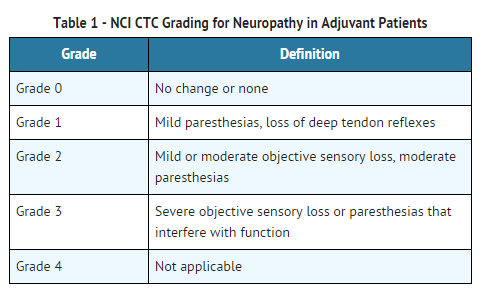
- Peripheral sensory neuropathy was reported in adjuvant patients treated with the Oxaliplatin combination with a frequency of 92% (all grades) and 13% (grade 3). At the 28-day follow-up after the last treatment cycle, 60% of all patients had any grade (Grade 1=40%, Grade 2=16%, Grade 3=5%) peripheral sensory neuropathy decreasing to 39% at 6 months follow-up (Grade 1=31%, Grade 2=7%, Grade 3=1%) and 21% at 18 months of follow-up (Grade 1=17%, Grade 2=3%, Grade 3=1%).
- In the advanced colorectal cancer studies, neuropathy was graded using a study-specific neurotoxicity scale, which was different from the NCI CTC scale, Version 2.0
- Overall, neuropathy was reported in patients previously untreated for advanced colorectal cancer in 82% (all grades) and 19% (grade 3/4), and in the previously treated patients in 74% (all grades) and 7% (grade 3/4) events. Information regarding reversibility of neuropathy was not available from the trial for patients who had not been previously treated for colorectal cancer.
Reversible Posterior Leukoencephalopathy Syndrome
- Reversible Posterior Leukoencephalopathy Syndrome (RPLS, also known as PRES, Posterior Reversible Encephalopathy Syndrome) has been observed in clinical trials (< 0.1%) and postmarketing experience. Signs and symptoms of RPLS could be headache, altered mental functioning, seizures, abnormal vision from blurriness to blindness, associated or not with hypertension. Diagnosis of RPLS is based upon confirmation by brain imaging.
Pulmonary Toxicity=
- Oxaliplatin has been associated with pulmonary fibrosis (<1% of study patients), which may be fatal. The combined incidence of cough and dyspnea was 7.4% (any grade) and <1% (grade 3) with no grade 4 events in the Oxaliplatin plus infusional 5-fluorouracil/Leucovorin arm compared to 4.5% (any grade) and no grade 3 and 0.1% grade 4 events in the infusional 5-fluorouracil/Leucovorin alone arm in adjuvant colon cancer patients. In this study, one patient died from eosinophilic pneumonia in the Oxaliplatin combination arm. The combined incidence of cough, dyspnea and hypoxia was 43% (any grade) and 7% (grade 3 and 4) in the Oxaliplatin plus 5-fluorouracil/Leucovorin arm compared to 32% (any grade) and 5% (grade 3 and 4) in the irinotecan plus 5-fluorouracil/Leucovorin arm of unknown duration for patients with previously untreated colorectal cancer. In case of unexplained respiratory symptoms such as non-productive cough, dyspnea, crackles, or radiological pulmonary infiltrates, Oxaliplatin should be discontinued until further pulmonary investigation excludes interstitial lung disease or pulmonary fibrosis.
Hepatotoxicity
- Hepatotoxicity as evidenced in the adjuvant study, by increase in transaminases (57% vs. 34%) and alkaline phosphatase (42% vs. 20%) was observed more commonly in the Oxaliplatin combination arm than in the control arm. The incidence of increased bilirubin was similar on both arms. Changes noted on liver biopsies include: peliosis, nodular regenerative hyperplasia or sinusoidal alterations, perisinusoidal fibrosis, and veno-occlusive lesions. Hepatic vascular disorders should be considered, and if appropriate, should be investigated in case of abnormal liver function test results or portal hypertension, which cannot be explained by liver metastases
Recommended Laboratory Tests
- Standard monitoring of the white blood cell count with differential, hemoglobin, platelet count, and blood chemistries (including ALT,AST, bilirubin and creatinine) is recommended before each Oxaliplatin cycle.
- There have been reports while on study and from post-marketing surveillance of prolonged prothrombin time and INR occasionally associated with hemorrhage in patients who received Oxaliplatin plus 5-fluorouracil/Leucovorin while on anticoagulants. Patients receiving Oxaliplatin plus 5-fluorouracil/Leucovorin and requiring oral anticoagulants may require closer monitoring.
Adverse Reactions
Clinical Trials Experience
Clinical Trials Experience
- Because clinical trials are conducted under widely varying conditions, adverse reaction rates observed in the clinical trials of a drug cannot be directly compared to rates in the clinical trials of another drug and may not reflect the rates observed in practice.
- More than 1100 patients with stage II or III colon cancer and more than 4,000 patients with advanced colorectal cancer have been treated in clinical studies with Oxaliplatin. The most common adverse reactions in patients with stage II or III colon cancer receiving adjuvant therapy were peripheral sensory neuropathy, neutropenia, thrombocytopenia, anemia, nausea, increase in transaminases and alkaline phosphatase, diarrhea, emesis, fatigue and stomatitis. The most common adverse reactions in previously untreated and treated patients were peripheral sensory neuropathies, fatigue, neutropenia, nausea, emesis, and diarrhea.
Combination Adjuvant Therapy with Oxaliplatin and Infusional 5-fluorouracil/Leucovorin in Patients with Colon Cancer
- One thousand one hundred and eight patients with stage II or III colon cancer, who had undergone complete resection of the primary tumor, have been treated in a clinical study with Oxaliplatin in combination with infusional 5-fluorouracil/Leucovorin. The incidence of grade 3 or 4 adverse reactions was 70% on the Oxaliplatin combination arm, and 31% on the infusional 5-fluorouracil/Leucovorin arm. The adverse reactions in this trial are shown in the tables below. Discontinuation of treatment due to adverse reactions occurred in 15% of the patients receiving Oxaliplatin and infusional 5-fluorouracil/Leucovorin. Both 5-fluorouracil/Leucovorin and Oxaliplatin are associated with gastrointestinal or hematologic adverse reactions. When Oxaliplatin is administered in combination with infusional 5-fluorouracil/Leucovorin, the incidence of these events is increased.
- The incidence of death within 28 days of last treatment, regardless of causality, was 0.5% (n=6) in both the Oxaliplatin combination and infusional 5-fluorouracil/Leucovorin arms, respectively. Deaths within 60 days from initiation of therapy were 0.3% (n=3) in both the Oxaliplatin combination and infusional 5-fluorouracil/Leucovorin arms, respectively. On the Oxaliplatin combination arm, 3 deaths were due to sepsis/neutropenic sepsis, 2 from intracerebral bleeding and one from eosinophilic pneumonia. On the 5-fluorouracil/Leucovorin arm, one death was due to suicide, 2 from Steven-Johnson Syndrome (1 patient also had sepsis), 1 unknown cause, 1 anoxic cerebral infarction and 1 probable abdominal aorta rupture.
- The following table provides adverse reactions reported in the adjuvant therapy colon cancer clinical trial by body system and decreasing order of frequency in the Oxaliplatin and infusional 5-fluorouracil/Leucovorin arm for events with overall incidences ≥ 5% and for NCI grade 3/4 events with incidences ≥ 1%.
- The following table provides adverse reactions reported in the adjuvant therapy colon cancer clinical trial by body system and decreasing order of frequency in the Oxaliplatin and infusional 5-fluorouracil/Leucovorin arm for events with overall incidences ≥ 5% but with incidences <1% NCI grade 3/4 events.
- Although specific events can vary, the overall frequency of adverse reactions was similar in men and women and in patients <65 and ≥65 years. However, the following grade 3/4 events were more common in females: diarrhea, fatigue, granulocytopenia, nausea and vomiting. In patients ≥65 years old, the incidence of grade 3/4 diarrhea and granulocytopenia was higher than in younger patients. Insufficient subgroup sizes prevented analysis of safety by race. The following additional adverse reactions, were reported in ≥2% and <5% of the patients in the Oxaliplatin and infusional 5-fluorouracil/Leucovorin combination arm (listed in decreasing order of frequency): pain, leukopenia, weight decrease, coughing.
- The number of patients who developed secondary malignancies was similar; 62 in the Oxaliplatin combination arm and 68 in the infusional 5-fluorouracil/Leucovorin arm. An exploratory analysis showed that the number of deaths due to secondary malignancies was 1.96% in the Oxaliplatin combination arm and 0.98% in infusional 5-fluorouracil/Leucovorin arm. In addition, the number of cardiovascular deaths was 1.4% in the Oxaliplatin combination arm as compared to 0.7% in the infusional 5-fluorouracil/Leucovorin arm. Clinical significance of these findings is unknown.
Patients Previously Untreated for Advanced Colorectal Cancer
- Two hundred and fifty-nine patients were treated in the Oxaliplatin and 5-fluorouracil/Leucovorin combination arm of the randomized trial in patients previously untreated for advanced colorectal cancer. The adverse reaction profile in this study was similar to that seen in other studies and the adverse reactions in this trial are shown in the tables below.
- Both 5-fluorouracil and Oxaliplatin are associated with gastrointestinal and hematologic adverse reactions. When Oxaliplatin is administered in combination with 5-fluorouracil, the incidence of these events is increased.
- The incidence of death within 30 days of treatment in the previously untreated for advanced colorectal cancer study, regardless of causality, was 3% with the Oxaliplatin and 5-fluorouracil/Leucovorin combination, 5% with irinotecan plus 5-fluorouracil/Leucovorin, and 3% with Oxaliplatin plus irinotecan. Deaths within 60 days from initiation of therapy were 2.3% with the Oxaliplatin and 5-fluorouracil/Leucovorin combination, 5.1% with irinotecan plus 5-fluorouracil/Leucovorin, and 3.1% with Oxaliplatin plus irinotecan.
- The following table provides adverse reactions reported in the previously untreated for advanced colorectal cancer study by body system and decreasing order of frequency in the Oxaliplatin and 5-fluorouracil/Leucovorin combination arm for events with overall incidences ≥5% and for grade 3/4 events with incidences ≥1%.
- The following table provides adverse reactions reported in the previously untreated for advanced colorectal cancer study by body system and decreasing order of frequency in the Oxaliplatin and 5-fluorouracil/Leucovorin combination arm for events with overall incidences ≥5% but with incidences <1% NCI Grade 3/4 events.
- Adverse reactions were similar in men and women and in patients <65 and ≥65 years, but older patients may have been more susceptible to diarrhea, dehydration, hypokalemia, leukopenia, fatigue and syncope. The following additional adverse reactions, at least possibly related to treatment and potentially important, were reported in ≥2% and <5% of the patients in the Oxaliplatin and 5-fluorouracil/Leucovorin combination arm (listed in decreasing order of frequency): metabolic, pneumonitis, catheter infection, vertigo, prothrombin time, pulmonary, rectal bleeding, dysuria, nail changes, chest pain, rectal pain, syncope, hypertension, hypoxia, unknown infection, bone pain, pigmentation changes, and urticaria.
Previously Treated Patients with Advanced Colorectal Cancer
- Four hundred and fifty patients (about 150 receiving the combination of Oxaliplatin and 5-fluorouracil/Leucovorin) were studied in a randomized trial in patients with refractory and relapsed colorectal cancer. The adverse reaction profile in this study was similar to that seen in other studies and the adverse reactions in this trial are shown in the tables below.
- Thirteen percent of patients in the Oxaliplatin and 5-fluorouracil/Leucovorin combination arm and 18% in the 5-fluorouracil/Leucovorin arm of the previously treated study had to discontinue treatment because of adverse effects related to gastrointestinal, or hematologic adverse reactions, or neuropathies. Both 5-fluorouracil and Oxaliplatin are associated with gastrointestinal and hematologic adverse reactions. When Oxaliplatin is administered in combination with 5-fluorouracil, the incidence of these events is increased.
- The incidence of death within 30 days of treatment in the previously treated study, regardless of causality, was 5% with the Oxaliplatin and 5-fluorouracil/Leucovorin combination, 8% with Oxaliplatin alone, and 7% with 5-fluorouracil/Leucovorin. Of the 7 deaths that occurred on the Oxaliplatin and 5-fluorouracil/Leucovorin combination arm within 30 days of stopping treatment, 3 may have been treatment related, associated with gastrointestinal bleeding or dehydration.
- The following table provides adverse reactions reported in the previously treated study by body system and in decreasing order of frequency in the Oxaliplatin and 5-fluorouracil/Leucovorin combination arm for events with overall incidences ≥5% and for grade 3/4 events with incidences ≥1%. This table does not include hematologic and blood chemistry abnormalities; these are shown separately below.
- The following table provides adverse reactions reported in the previously treated study by body system and in decreasing order of frequency in the Oxaliplatin and 5-fluorouracil/Leucovorin combination arm for events with overall incidences ≥5% but with incidences <1% NCI Grade 3/4 events.
- Adverse reactions were similar in men and women and in patients <65 and ≥65 years, but older patients may have been more susceptible to dehydration, diarrhea, hypokalemia and fatigue. The following additional adverse reactions, at least possibly related to treatment and potentially important, were reported in ≥2% and <5% of the patients in the Oxaliplatin and 5-fluorouracil/Leucovorin combination arm (listed in decreasing order of frequency): anxiety, myalgia, erythematous rash, increased sweating, conjunctivitis, weight decrease, dry mouth, rectal hemorrhage, depression, ataxia, ascites, hemorrhoids, muscle weakness, nervousness, tachycardia, abnormal micturition frequency, dry skin, pruritus, hemoptysis, purpura, vaginal hemorrhage, melena, somnolence, pneumonia, proctitis, involuntary muscle contractions, intestinal obstruction, gingivitis, tenesmus, hot flashes, enlarged abdomen, urinary incontinence.
Hematologic Changes
- The following tables list the hematologic changes occurring in ≥5% of patients, based on laboratory values and NCI grade, with the exception of those events occurring in adjuvant patients and anemia in the patients previously untreated for advanced colorectal cancer, respectively, which are based on AE reporting and NCI grade alone.
Thrombocytopenia and Bleeding
- Thrombocytopenia was frequently reported with the combination of Oxaliplatin and infusional 5-fluorouracil/Leucovorin. The incidence of all hemorrhagic events in the adjuvant and previously treated patients was higher on the Oxaliplatin combination arm compared to the infusional 5-fluorouracil/Leucovorin arm. These events included gastrointestinal bleeding, hematuria, and epistaxis. In the adjuvant trial, two patients died from intracerebral hemorrhages.
- The incidence of Grade 3/4 thrombocytopenia was 2% in adjuvant patients with colon cancer. In patients treated for advanced colorectal cancer the incidence of Grade 3/4 thrombocytopenia was 3–5%, and the incidence of these events was greater for the combination of Oxaliplatin and 5-fluorouracil/Leucovorin over the irinotecan plus 5-fluorouracil/Leucovorin or 5-fluorouracil/Leucovorin control groups. Grade 3/4 gastrointestinal bleeding was reported in 0.2% of adjuvant patients receiving Oxaliplatin and 5-fluorouracil/Leucovorin. In the previously untreated patients, the incidence of epistaxis was 10% in the Oxaliplatin and 5-fluorouracil/Leucovorin arm, and 2% and 1%, respectively, in the irinotecan plus 5-fluorouracil/Leucovorin or irinotecan plus Oxaliplatin arms.
Neutropenia
- Neutropenia was frequently observed with the combination of Oxaliplatin and 5-fluorouracil/Leucovorin, with Grade 3 and 4 events reported in 29% and 12% of adjuvant patients with colon cancer, respectively. In the adjuvant trial, 3 patients died from sepsis/neutropenic sepsis. Grade 3 and 4 events were reported in 35% and 18% of the patients previously untreated for advanced colorectal cancer, respectively. Grade 3 and 4 events were reported in 27% and 17% of previously treated patients, respectively. In adjuvant patients the incidence of either febrile neutropenia (0.7%) or documented infection with concomitant grade 3/4 neutropenia (1.1%) was 1.8% in the Oxaliplatin and 5-fluorouracil/Leucovorin arm. The incidence of febrile neutropenia in the patients previously untreated for advanced colorectal cancer was 15% (3% of cycles) in the irinotecan plus 5-fluorouracil/Leucovorin arm and 4% (less than 1% of cycles) in the Oxaliplatin and 5-fluorouracil/Leucovorin combination arm. Additionally, in this same population, infection with grade 3 or 4 neutropenia was 12% in the irinotecan plus 5-fluorouracil/Leucovorin, and 8% in the Oxaliplatin and 5-fluorouracil/Leucovorin combination. The incidence of febrile neutropenia in the previously treated patients was 1% in the 5-fluorouracil/Leucovorin arm and 6% (less than 1% of cycles) in the Oxaliplatin and 5-fluorouracil/Leucovorin combination arm.
Gastrointestinal
- In patients receiving the combination of Oxaliplatin plus infusional 5-fluorouracil/Leucovorin for adjuvant treatment for colon cancer the incidence of Grade 3/4 nausea and vomiting was greater than those receiving infusional 5-fluorouracil/Leucovorin alone (see table). In patients previously untreated for advanced colorectal cancer receiving the combination of Oxaliplatin and 5-fluorouracil/Leucovorin, the incidence of Grade 3 and 4 vomiting and diarrhea was less compared to irinotecan plus 5-fluorouracil/Leucovorin controls (see table). In previously treated patients receiving the combination of Oxaliplatin and 5-fluorouracil/Leucovorin, the incidence of Grade 3 and 4 nausea, vomiting, diarrhea, and mucositis/stomatitis increased compared to 5-fluorouracil/Leucovorin controls (see table).
- The incidence of gastrointestinal adverse reactions in the previously untreated and previously treated patients appears to be similar across cycles. Premedication with antiemetics, including 5-HT3 blockers, is recommended. Diarrhea and mucositis may be exacerbated by the addition of Oxaliplatin to 5-fluorouracil/Leucovorin, and should be managed with appropriate supportive care. Since cold temperature can exacerbate acute neurological symptoms, ice (mucositis prophylaxis) should be avoided during the infusion of Oxaliplatin.
Dermatologic
- Oxaliplatin did not increase the incidence of alopecia compared to 5-fluorouracil/Leucovorin alone. No complete alopecia was reported. The incidence of Grade 3/4 skin disorders was 2% in both the Oxaliplatin plus infusional 5-fluorouracil/Leucovorin and the infusional 5-fluorouracil/Leucovorin alone arms in the adjuvant colon cancer patients. The incidence of hand-foot syndrome in patients previously untreated for advanced colorectal cancer was 2% in the irinotecan plus 5-fluorouracil/Leucovorin arm and 7% in the Oxaliplatin and 5-fluorouracil/Leucovorin combination arm. The incidence of hand-foot syndrome in previously treated patients was 13% in the 5-fluorouracil/Leucovorin arm and 11% in the Oxaliplatin and 5-fluorouracil/Leucovorin combination arm.
Intravenous Site Reactions
- Extravasation, in some cases including necrosis, has been reported.
Injection site reaction, including redness, swelling, and pain, has been reported.
Anticoagulation and Hemorrhage
- There have been reports while on study and from post-marketing surveillance of prolonged prothrombin time and INR occasionally associated with hemorrhage in patients who received Oxaliplatin plus 5-fluorouracil/Leucovorin while on anticoagulants. Patients receiving Oxaliplatin plus 5-fluorouracil/Leucovorin and requiring oral anticoagulants may require closer monitoring.
Renal
- About 5–10% of patients in all groups had some degree of elevation of serum creatinine. The incidence of Grade 3/4 elevations in serum creatinine in the Oxaliplatin and 5-fluorouracil/Leucovorin combination arm was 1% in the previously treated patients. Serum creatinine measurements were not reported in the adjuvant trial.
Hepatic
- Hepatotoxicity (defined as elevation of liver enzymes) appears to be related to Oxaliplatin combination therapy. The following tables list the clinical chemistry changes associated with hepatic toxicity occurring in ≥5% of patients, based on adverse reactions reported and NCI CTC grade for adjuvant patients and patients previously untreated for advanced colorectal cancer, laboratory values and NCI CTC grade for previously treated patients.
Thromboembolism
- The incidence of thromboembolic events in adjuvant patients with colon cancer was 6% (1.8% grade 3/4) in the infusional 5-fluorouracil/Leucovorin arm and 6% (1.2% grade 3/4) in the Oxaliplatin and infusional 5-fluorouracil/Leucovorin combined arm, respectively. The incidence was 6 and 9% of the patients previously untreated for advanced colorectal cancer and previously treated patients in the Oxaliplatin and 5-fluorouracil/Leucovorin combination arm, respectively
Postmarketing Experience
- The following adverse reactions have been identified during post-approval use of Oxaliplatin. Because these reactions are reported voluntarily from a population of uncertain size, it is not always possible to reliably estimate their frequency or establish a causal relationship to drug exposure.
Body as a whole
Central and peripheral nervous system disorders
- loss of deep tendon reflexes, dysarthria, Lhermitte's sign, cranial nerve palsies, fasciculations, convulsion, Reversible Posterior Leukoencephalopathy Syndrome (RPLS, also known as PRES).
Hearing and vestibular system disorders
Infusion reactions/hypersensitivity
- laryngospasm
Liver and Gastrointestinal system disorders
- severe diarrhea/vomiting resulting in hypokalemia, colitis (including Clostridium difficile diarrhea), metabolic acidosis; ileus; intestinal obstruction, pancreatitis; veno-occlusive disease of liver also known as sinusoidal obstruction syndrome, and perisinusoidal fibrosis which rarely may progress.
Platelet, bleeding, and clotting disorders
- immuno-allergic thrombocytopenia
prolongation of prothrombin time and of INR in patients receiving anticoagulants
Red Blood Cell disorders
- hemolytic uremic syndrome, immuno-allergic hemolytic anemia
Renal disorders
Respiratory system disorders
- pulmonary fibrosis, and other interstitial lung diseases (sometimes fatal)
Vision disorders
- decrease of visual acuity, visual field disturbance, optic neuritis and transient vision loss (reversible following therapy discontinuation)
Drug Interactions
- No specific cytochrome P-450-based drug interaction studies have been conducted. No pharmacokinetic interaction between 85 mg/m2 Oxaliplatin and 5-fluorouracil/Leucovorin has been observed in patients treated every 2 weeks. Increases of 5-fluorouracil plasma concentrations by approximately 20% have been observed with doses of 130 mg/m2 Oxaliplatin dosed every 3 weeks. Because platinum-containing species are eliminated primarily through the kidney, clearance of these products may be decreased by coadministration of potentially nephrotoxic compounds; although, this has not been specifically studied
Use in Specific Populations
Pregnancy
- Based on direct interaction with DNA, Oxaliplatin may cause fetal harm when administered to a pregnant woman. There are no adequate and well-controlled studies of Oxaliplatin in pregnant women. Reproductive toxicity studies in rats demonstrated adverse effects on fertility and embryo-fetal development at maternal doses that were below the recommended human dose based on body surface area. If this drug is used during pregnancy or if the patient becomes pregnant while taking this drug, the patient should be apprised of the potential hazard to the fetus. Women of childbearing potential should be advised to avoid becoming pregnant and use effective contraception while receiving treatment with Oxaliplatin.
- Pregnant rats were administered oxaliplatin at less than one-tenth the recommended human dose based on body surface area during gestation days 1–5 (pre-implantation), 6–10, or 11–16 (during organogenesis). Oxaliplatin caused developmental mortality (increased early resorptions) when administered on days 6–10 and 11–16 and adversely affected fetal growth (decreased fetal weight, delayed ossification) when administered on days 6–10. Administration of oxaliplatin to male and female rats prior to mating resulted in 97% post-implantation loss in animals that received approximately one-seventh the recommended human dose based on the body surface area.
Pregnancy Category (AUS):
There is no Australian Drug Evaluation Committee (ADEC) guidance on usage of Oxaliplatin in women who are pregnant.
Labor and Delivery
There is no FDA guidance on use of Oxaliplatin during labor and delivery.
Nursing Mothers
- It is not known whether Oxaliplatin or its derivatives are excreted in human milk. Because many drugs are excreted in human milk and because of the potential for serious adverse reactions in nursing infants from Oxaliplatin, a decision should be made whether to discontinue nursing or discontinue the drug, taking into account the importance of the drug to the mother.
Pediatric Use
- The effectiveness of oxaliplatin in children has not been established. Oxaliplatin has been tested in 2 Phase 1 and 2 Phase 2 trials in 235 patients ages 7 months to 22 years with solid tumors (see below) and no significant activity observed.
- In a Phase 1/2 study, oxaliplatin was administered as a 2-hour intravenous infusion on Days 1, 8 and 15 every 4 weeks (1 cycle), for a maximum of 6 cycles, to 43 patients with refractory or relapsed malignant solid tumors, mainly neuroblastoma and osteosarcoma. Twenty eight pediatric patients in the Phase 1 study received oxaliplatin at 6 dose levels starting at 40 mg/m2 with escalation to 110 mg/m2. The dose limiting toxicity (DLT) was sensory neuropathy at the 110 mg/m2 dose. Fifteen patients received oxaliplatin at a dose of 90 mg/m2 intravenous in the Phase 2 portion of the study. At this dose, paresthesia (60%, G3/4: 7%), fever (40%, G3/4: 7%) and thrombocytopenia (40%, G3/4: 27%) were the main adverse reactions. No responses were observed.
- In a second Phase 1 study, oxaliplatin was administered to 26 pediatric patients as a 2-hour intravenous infusion on day 1 every 3 weeks (1 cycle) at 5 dose levels starting at 100 mg/m2 with escalation to 160 mg/m2, for a maximum of 6 cycles. In a separate cohort, oxaliplatin 85 mg/m2 was administered on day 1 every 2 weeks, for a maximum of 9 doses. Patients had metastatic or unresectable solid tumors mainly neuroblastoma and ganglioneuroblastoma. No responses were observed. The DLT was sensory neuropathy at the 160 mg/m2 dose. Based on these studies, oxaliplatin 130 mg/m2 as a 2-hour intravenous infusion on day 1 every 3 weeks (1 cycle) was used in subsequent Phase II studies. A dose of 85 mg/m2 on day 1 every 2 weeks was also found to be tolerable.
- In one Phase 2 study, 43 pediatric patients with recurrent or refractory embryonal CNS tumors received oxaliplatin 130 mg/m2 every 3 weeks for a maximum of 12 months in absence of progressive disease or unacceptable toxicity. In patients < 10 kg the oxaliplatin dose used was 4.3 mg/kg. The most common adverse reactions reported were leukopenia (67%, G3/4: 12%), anemia (65%, G3/4: 5%), thrombocytopenia (65%, G3/4: 26%), vomiting (65%, G3/4: 7%), neutropenia (58%, G3/4: 16%) and sensory neuropathy (40%, G3/4: 5%). One partial response was observed.
- In a second Phase 2 study, 123 pediatric patients with recurrent solid tumors, including neuroblastoma, osteosarcoma, Ewing sarcoma or peripheral PNET, ependymoma, rhabdomyosarcoma, hepatoblastoma, high grade astrocytoma, Brain stem glioma, low grade astrocytoma, malignant germ cell tumor and other tumors of interest received oxaliplatin 130 mg/m2 every 3 weeks for a maximum of 12 months or 17 cycles. In patients ≤ 12 months old the oxaliplatin dose used was 4.3 mg/kg. The most common adverse reactions reported were sensory neuropathy (52%, G3/4: 12%), thrombocytopenia (37%, G3/4: 17%), anemia (37%, G3/4: 9%), vomiting (26%, G3/4:4%), ALT increased (24%, G3/4: 6%), AST increased (24%, G3/4: 2%), and nausea (23%, G3/:4 3%). Two partial responses were observed.
- The pharmacokinetic parameters of ultrafiltrable platinum have been evaluated in 105 pediatric patients during the first cycle. The mean clearance in pediatric patients estimated by the population pharmacokinetic analysis was 4.7 L/h. The inter-patient variability of platinum clearance in pediatric cancer patients was 41%. Mean platinum pharmacokinetic parameters in ultrafiltrate were Cmax of 0.75 ± 0.24 mcg/mL, AUC0–48 of 7.52 ± 5.07 mcg∙h/mL and AUCinf of 8.83 ± 1.57 mcg∙h/mL at 85 mg/m2 of oxaliplatin and Cmax of 1.10 ± 0.43 mcg/mL, AUC0–48 of 9.74 ± 2.52 mcg∙h/mL and AUCinf of 17.3 ± 5.34 mcg∙h/mL at 130 mg/m2 of oxaliplatin.
Geriatic Use
- No significant effect of age on the clearance of ultrafilterable platinum has been observed.
- In the adjuvant therapy colon cancer randomized clinical trial, 723 patients treated with Oxaliplatin and infusional 5-fluorouracil/Leucovorin were <65 years and 400 patients were ≥65 years.
- A descriptive subgroup analysis demonstrated that the improvement in DFS for the Oxaliplatin combination arm compared to the infusional 5-fluorouracil/Leucovorin alone arm appeared to be maintained across genders. The effect of Oxaliplatin in patients ≥65 years of age was not conclusive. Insufficient subgroup sizes prevented analysis by race.
- Patients ≥ 65 years of age receiving the Oxaliplatin combination therapy experienced more grade 3–4 granulocytopenia than patients < 65 years of age (45% versus 39%).
- In the previously untreated for advanced colorectal cancer randomized clinical trial of Oxaliplatin, 160 patients treated with Oxaliplatin and 5-fluorouracil/Leucovorin were < 65 years and 99 patients were ≥65 years. The same efficacy improvements in response rate, time to tumor progression, and overall survival were observed in the ≥65 year old patients as in the overall study population. In the previously treated for advanced colorectal cancer randomized clinical trial of Oxaliplatin, 95 patients treated with Oxaliplatin and 5-fluorouracil/Leucovorin were <65 years and 55 patients were ≥65 years. The rates of overall adverse reactions, including grade 3 and 4 events, were similar across and within arms in the different age groups in all studies. The incidence of diarrhea, dehydration, hypokalemia, leukopenia, fatigue and syncope were higher in patients ≥65 years old. No adjustment to starting dose was required in patients ≥65 years old.
Gender
There is no FDA guidance on the use of Oxaliplatin with respect to specific gender populations.
Race
There is no FDA guidance on the use of Oxaliplatin with respect to specific racial populations.
Renal Impairment
- The exposure (AUC) of unbound platinum in plasma ultrafiltrate tends to increase in renally impaired patients. Caution and close monitoring should be exercised when Oxaliplatin is administered to patients with renal impairment. The starting Oxaliplatin dose does not need to be reduced in patients with mild (creatinine clearance=50-80 mL/min) or moderate (creatinine clearance=30-49 mL/min) renal impairment. However, the starting dose of Oxaliplatin should be reduced in patients with severe renal impairment (creatinine clearance < 30 mL/min)
Hepatic Impairment
There is no FDA guidance on the use of Oxaliplatin in patients with hepatic impairment.
Females of Reproductive Potential and Males
There is no FDA guidance on the use of Oxaliplatin in women of reproductive potentials and males.
Immunocompromised Patients
There is no FDA guidance one the use of Oxaliplatin in patients who are immunocompromised.
Administration and Monitoring
Administration
- Intravenous
Monitoring
- Monitor for development of rash, urticaria, erythema, pruritis, bronchospasm, and hypotension
- Hepatotoxicity: Monitor liver function tests.
- Caution and close monitoring should be exercised when Oxaliplatin is administered to patients with renal impairment.
IV Compatibility
There is limited information regarding IV Compatibility of Oxaliplatin in the drug label.
Overdosage
- There is no known antidote for Oxaliplatin overdose. In addition to thrombocytopenia, the anticipated complications of an Oxaliplatin overdose include hypersensitivity reaction, myelosuppression, nausea, vomiting, diarrhea and neurotoxicity.
- Several cases of overdoses have been reported with Oxaliplatin. Adverse reactions observed were Grade 4 thrombocytopenia (<25,000/mm3) without any bleeding, anemia, sensory neuropathy such as paresthesia, dysesthesia, laryngospasm and facial muscle spasms, gastrointestinal disorders such as nausea, vomiting, stomatitis, flatulence, abdomen enlarged and Grade 4 intestinal obstruction, Grade 4 dehydration, dyspnea, wheezing, chest pain, respiratory failure, severe bradycardia and death.
- Patients suspected of receiving an overdose should be monitored, and supportive treatment should be administered. The maximum dose of oxaliplatin that has been administered in a single infusion is 825 mg.
Pharmacology
There is limited information regarding Oxaliplatin Pharmacology in the drug label.
Mechanism of Action
- Oxaliplatin undergoes nonenzymatic conversion in physiologic solutions to active derivatives via displacement of the labile oxalate ligand. Several transient reactive species are formed, including monoaquo and diaquo DACH platinum, which covalently bind with macromolecules. Both inter- and intrastrand Pt-DNA crosslinks are formed. Crosslinks are formed between the N7 positions of two adjacent guanines (GG), adjacent adenine-guanines (AG), and guanines separated by an intervening nucleotide (GNG). These crosslinks inhibit DNA replication and transcription. Cytotoxicity is cell-cycle nonspecific.
- In vivo studies have shown antitumor activity of oxaliplatin against colon carcinoma. In combination with , oxaliplatin exhibits in vitro and in vivo antiproliferative activity greater than either compound alone in several tumor models [HT29 (colon), GR (mammary), and L1210 (leukemia)].
Structure
- Oxaliplatin® (oxaliplatin injection) is an antineoplastic agent with the molecular formula C8H14N2O4Pt and the chemical name of cis-[(1 R,2 R)-1,2-cyclohexanediamine-N,N'] [oxalato(2-)- O,O'] platinum. Oxaliplatin is an organoplatinum complex in which the platinum atom is complexed with 1,2-diaminocyclohexane(DACH) and with an oxalate ligand as a leaving group.
- The molecular weight is 397.3. Oxaliplatin is slightly soluble in water at 6 mg/mL, very slightly soluble in methanol, and practically insoluble in ethanol and acetone.
- Oxaliplatin is supplied in vials containing 50 mg or 100 mg of oxaliplatin as a sterile, preservative-free, aqueous solution at a concentration of 5 mg/mL. Water for Injection, USP is present as an inactive ingredient.
Pharmacodynamics
There is limited information regarding Pharmacodynamics of Oxaliplatin in the drug label.
Pharmacokinetics
- The reactive oxaliplatin derivatives are present as a fraction of the unbound platinum in plasma ultrafiltrate. The decline of ultrafilterable platinum levels following oxaliplatin administration is triphasic, characterized by two relatively short distribution phases (t1/2α; 0.43 hours and t1/2β; 16.8 hours) and a long terminal elimination phase (t1/2γ; 391 hours). Pharmacokinetic parameters obtained after a single 2-hour intravenous infusion of Oxaliplatin at a dose of 85 mg/m2 expressed as ultrafilterable platinum were Cmax of 0.814 mcg/mL and volume of distribution of 440 L.
Interpatient and intrapatient variability in ultrafilterable platinum exposure (AUC0–48hr) assessed over 3 cycles was moderate to low (23% and 6%, respectively). A pharmacodynamic relationship between platinum ultrafiltrate levels and clinical safety and effectiveness has not been established.
Distribution
- At the end of a 2-hour infusion of Oxaliplatin, approximately 15% of the administered platinum is present in the systemic circulation. The remaining 85% is rapidly distributed into tissues or eliminated in the urine. In patients, plasma protein binding of platinum is irreversible and is greater than 90%. The main binding proteins are albumin and gamma-globulins. Platinum also binds irreversibly and accumulates (approximately 2-fold) in erythrocytes, where it appears to have no relevant activity. No platinum accumulation was observed in plasma ultrafiltrate following 85 mg/m2 every two weeks.
Metabolism
- Oxaliplatin undergoes rapid and extensive nonenzymatic biotransformation. There is no evidence of cytochrome P450-mediated metabolism in vitro.
- Up to 17 platinum-containing derivatives have been observed in plasma ultrafiltrate samples from patients, including several cytotoxic species (monochloro DACH platinum, dichloro DACH platinum, and monoaquo and diaquo DACH platinum) and a number of noncytotoxic, conjugated species.
Elimination
- The major route of platinum elimination is renal excretion. At five days after a single 2-hour infusion of Oxaliplatin, urinary elimination accounted for about 54% of the platinum eliminated, with fecal excretion accounting for only about 2%. Platinum was cleared from plasma at a rate (10 – 17 L/h) that was similar to or exceeded the average human glomerular filtration rate (GFR; 7.5 L/h). There was no significant effect of gender on the clearance of ultrafilterable platinum. The renal clearance of ultrafilterable platinum is significantly correlated with GFR.
Pharmacokinetics in Special Populations
Renal Impairment
- A study was conducted in 38 patients with advanced GI cancer and varying degrees of renal impairment. Patients in the normal (creatinine clearance (CrCL) > 80 mL/min, N=11), mild (CrCL=50-80 mL/min, N=13), and moderate (CrCL=30-49 mL/min, N=10) groups were treated with 85 mg/m2 Oxaliplatin and those in the severe (CrCL < 30 mL/min, N=4) group were treated with 65 mg/m2 Oxaliplatin. The mean AUC of unbound platinum was 40%, 95%, and 342% higher in the mild, moderate, and severe groups, respectively, than in the normal group. Mean Cmax of unbound platinum appeared to be similar among the normal, mild and moderate renal function groups, but was 38% higher in the severe group than in the normal group. Caution should be exercised in renally impaired patients. The starting dose of Oxaliplatin should be reduced in patients with severe renal impairment. The starting dose of Oxaliplatin should be reduced in patients with severe renal impairment.
Drug - Drug Interactions
- No pharmacokinetic interaction between 85 mg/m2 of Oxaliplatin and infusional 5-fluorouracil has been observed in patients treated every 2 weeks, but increases of 5-fluorouracil plasma concentrations by approximately 20% have been observed with doses of 130 mg/m2 of Oxaliplatin administered every 3 weeks. In vitro, platinum was not displaced from plasma proteins by the following medications: erythromycin, salicylate, sodium valproate, granisetron, and paclitaxel. In vitro, oxaliplatin is not metabolized by, nor does it inhibit, human cytochrome P450 isoenzymes. No P450-mediated drug-drug interactions are therefore anticipated in patients.
- Since platinum-containing species are eliminated primarily through the kidney, clearance of these products may be decreased by co-administration of potentially nephrotoxic compounds, although this has not been specifically studied.
Nonclinical Toxicology
Carcinogenesis, Mutagenesis, Impairment of Fertility
- Long-term animal studies have not been performed to evaluate the carcinogenic potential of oxaliplatin. Oxaliplatin was not mutagenic to bacteria (Ames test) but was mutagenic to mammalian cells in vitro (L5178Y mouse lymphoma assay). Oxaliplatin was clastogenic both in vitro (chromosome aberration in human lymphocytes) and in vivo (mouse bone marrow micronucleus assay).
- In a fertility study, male rats were given oxaliplatin at 0, 0.5, 1, or 2 mg/kg/day for five days every 21 days for a total of three cycles prior to mating with females that received two cycles of oxaliplatin on the same schedule. A dose of 2 mg/kg/day (less than one-seventh the recommended human dose on a body surface area basis) did not affect pregnancy rate, but caused developmental mortality (increased early resorptions, decreased live fetuses, decreased live births) and delayed growth (decreased fetal weight).
- Testicular damage, characterized by degeneration, hypoplasia, and atrophy, was observed in dogs administered oxaliplatin at 0.75 mg/kg/day × 5 days every 28 days for three cycles. A no effect level was not identified. This daily dose is approximately one-sixth of the recommended human dose on a body surface area basis.
Clinical Studies
Combination Adjuvant Therapy with Oxaliplatin and Infusional 5-fluorouracil/Leucovorin in Patients with Colon Cancer
- An international, multicenter, randomized study compared the efficacy and evaluated the safety of Oxaliplatin in combination with an infusional schedule of 5-fluorouracil/Leucovorin to infusional 5-fluorouracil/Leucovorin alone, in patients with stage II (Dukes' B2) or III (Dukes' C) colon cancer who had undergone complete resection of the primary tumor. The primary objective of the study was to compare the 3-year disease-free survival (DFS) in patients receiving Oxaliplatin and infusional 5-fluorouracil/Leucovorin to those receiving 5-fluorouracil/Leucovorin alone. Patients were to be treated for a total of 6 months (i.e., 12 cycles). A total of 2246 patients were randomized; 1123 patients per study arm. Patients in the study had to be between 18 and 75 years of age, have histologically proven stage II (T3–T4 N0 M0; Dukes' B2) or III (any T N1–2 M0; Dukes' C) colon carcinoma (with the inferior pole of the tumor above the peritoneal reflection, i.e., ≥15 cm from the anal margin) and undergone (within 7 weeks prior to randomization) complete resection of the primary tumor without gross or microscopic evidence of residual disease. Patients had to have had no prior chemotherapy, immunotherapy or radiotherapy, and have an ECOG performance status of 0,1, or 2 (KPS ≥ 60%), absolute neutrophil count (ANC) > 1.5x109/L, platelets ≥100×109/L, serum creatinine ≤ 1.25 × ULN total bilirubin < 2 × ULN, AST/ALT < 2 × ULN and carcino-embyrogenic antigen (CEA) < 10 ng/mL. Patients with preexisting peripheral neuropathy (NCI grade ≥ 1) were ineligible for this trial.
- The following table shows the dosing regimens for the two arms of the study.
- The following tables show the baseline characteristics and dosing of the patient population entered into this study. The baseline characteristics were well balanced between arms.
- The following table and figures summarize the disease-free survival (DFS) results in the overall randomized population and in patients with stage II and III disease based on an ITT analysis. The median duration of follow-up was approximately 77 months.
- In the overall and stage III colon cancer populations DFS was statistically significantly improved in the Oxaliplatin combination arm compared to infusional 5-fluorouracil/Leucovorin alone. However, a statistically significant improvement in DFS was not noted in Stage II patients.
- Figure 2 shows the DFS Kaplan-Meier curves for the comparison of Oxaliplatin and infusional 5-fluorouracil/Leucovorin combination and infusional 5-fluorouracil/Leucovorin alone for the overall population (ITT analysis).
- Figure 3 shows the DFS Kaplan-Meier curves for the comparison of Oxaliplatin and infusional 5-fluorouracil/Leucovorin combination and infusional 5-fluorouracil/Leucovorin alone in Stage III patients.
- The following table summarizes the overall survival (OS) results in the overall randomized population and in patients with stage II and III disease, based on the ITT analysis.
Combination Therapy with Oxaliplatin and 5-fluorouracil/Leucovorin in Patients Previously Untreated for Advanced Colorectal Cancer
- A North American, multicenter, open-label, randomized controlled study was sponsored by the National Cancer Institute (NCI) as an intergroup study led by the North Central Cancer Treatment Group (NCCTG). The study had 7 arms at different times during its conduct, four of which were closed due to either changes in the standard of care, toxicity, or simplification. During the study, the control arm was changed to irinotecan plus 5-fluorouracil/Leucovorin. The results reported below compared the efficacy and safety of two experimental regimens, Oxaliplatin in combination with infusional 5-fluorouracil/Leucovorin and a combination of Oxaliplatin plus irinotecan, to an approved control regimen of irinotecan plus 5-fluorouracil/Leucovorin in 795 concurrently randomized patients previously untreated for locally advanced or metastatic colorectal cancer. After completion of enrollment, the dose of irinotecan plus 5-fluorouracil/Leucovorin was decreased due to toxicity. Patients had to be at least 18 years of age, have known locally advanced, locally recurrent, or metastatic colorectal adenocarcinoma not curable by surgery or amenable to radiation therapy with curative intent, histologically proven colorectal adenocarcinoma, measurable or evaluable disease, with an ECOG performance status 0,1, or 2. Patients had to have granulocyte count ≥ 1.5 × 109/L, platelets ≥ 100 × 109/L, hemoglobin ≥9.0 gm/dL, creatinine ≤ 1.5 × ULN, total bilirubin ≤ 1.5 mg/dL, AST ≤ 5 × ULN, and alkaline phosphatase ≤ 5 × ULN. Patients may have received adjuvant therapy for resected Stage II or III disease without recurrence within 12 months. The patients were stratified for ECOG performance status (0, 1 vs. 2), prior adjuvant chemotherapy (yes vs. no), prior immunotherapy (yes vs. no), and age (<65 vs. ≥65 years). Although no post study treatment was specified in the protocol, 65 to 72% of patients received additional post study chemotherapy after study treatment discontinuation on all arms. Fifty-eight percent of patients on the Oxaliplatin plus 5-fluorouracil/Leucovorin arm received an irinotecan-containing regimen and 23% of patients on the irinotecan plus 5-fluorouracil/Leucovorin arm received oxaliplatin-containing regimens. Oxaliplatin was not commercially available during the trial.
- The following table presents the dosing regimens of the three arms of the study.
- The following table presents the demographics of the patient population entered into this study.
- The length of a treatment cycle was 2 weeks for the Oxaliplatin and 5-fluorouracil/Leucovorin regimen; 6 weeks for the irinotecan plus 5-fluorouracil/Leucovorin regimen; and 3 weeks for the Oxaliplatin plus irinotecan regimen. The median number of cycles administered per patient was 10 (23.9 weeks) for the Oxaliplatin and 5-fluorouracil/Leucovorin regimen, 4 (23.6 weeks) for the irinotecan plus 5-fluorouracil/Leucovorin regimen, and 7 (21.0 weeks) for the Oxaliplatin plus irinotecan regimen. Patients treated with the Oxaliplatin and 5-fluorouracil/Leucovorin combination had a significantly longer time to tumor progression based on investigator assessment, longer overall survival, and a significantly higher confirmed response rate based on investigator assessment compared to patients given irinotecan plus 5-fluorouracil/Leucovorin. The following table summarizes the efficacy results.
- A descriptive subgroup analysis demonstrated that the improvement in survival for Oxaliplatin plus 5-fluorouracil/Leucovorin compared to irinotecan plus 5-fluorouracil/Leucovorin appeared to be maintained across age groups, prior adjuvant therapy, and number of organs involved. An estimated survival advantage in Oxaliplatin plus 5-fluorouracil/Leucovorin versus irinotecan plus 5-fluorouracil/Leucovorin was seen in both genders; however it was greater among women than men. Insufficient subgroup sizes prevented analysis by race.
Combination Therapy with Oxaliplatin and 5-fluorouracil/Leucovorin in Previously Treated Patients with Advanced Colorectal Cancer
- A multicenter, open-label, randomized, three-arm controlled study was conducted in the US and Canada comparing the efficacy and safety of Oxaliplatin in combination with an infusional schedule of 5-fluorouracil/Leucovorin to the same dose and schedule of 5-fluorouracil/Leucovorin alone and to single agent oxaliplatin in patients with advanced colorectal cancer who had relapsed/progressed during or within 6 months of first-line therapy with bolus 5-fluorouracil/Leucovorin and irinotecan. The study was intended to be analyzed for response rate after 450 patients were enrolled. Survival will be subsequently assessed in all patients enrolled in the completed study. Accrual to this study is complete, with 821 patients enrolled. Patients in the study had to be at least 18 years of age, have unresectable, measurable, histologically proven colorectal adenocarcinoma, with a Karnofsky performance status >50%. Patients had to have SGOT(AST) and SGPT(ALT) ≤2× the institution's upper limit of normal (ULN), unless liver metastases were present and documented at baseline by CT or MRI scan, in which case ≤5× ULN was permitted. Patients had to have alkaline phosphatase ≤2× the institution's ULN, unless liver metastases were present and documented at baseline by CT or MRI scan, in which cases ≤5× ULN was permitted. Prior radiotherapy was permitted if it had been completed at least 3 weeks before randomization.
- The dosing regimens of the three arms of the study are presented in the table below.
- Patients entered into the study for evaluation of response must have had at least one unidimensional lesion measuring ≥20mm using conventional CT or MRI scans, or ≥10mm using a spiral CT scan. Tumor response and progression were assessed every 3 cycles (6 weeks) using the Response Evaluation Criteria in Solid Tumors (RECIST) until radiological documentation of progression or for 13 months following the first dose of study drug(s), whichever came first. Confirmed responses were based on two tumor assessments separated by at least 4 weeks.
The demographics of the patient population entered into this study are shown in the table below:
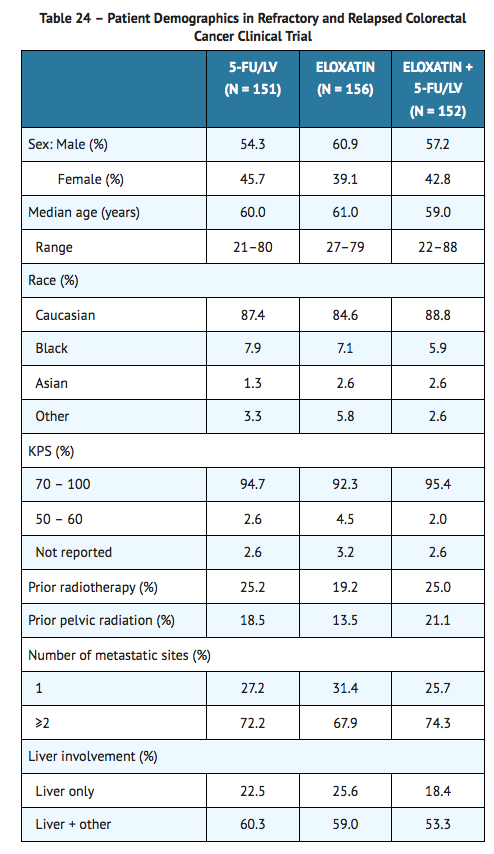
- The median number of cycles administered per patient was 6 for the Oxaliplatin and 5-fluorouracil/Leucovorin combination and 3 each for 5-fluorouracil/Leucovorin alone and Oxaliplatin alone.
- Patients treated with the combination of Oxaliplatin and 5-fluorouracil/Leucovorin had an increased response rate compared to patients given 5-fluorouracil/Leucovorin or oxaliplatin alone. The efficacy results are summarized in the tables below.
- At the time of the interim analysis 49% of the radiographic progression events had occurred. In this interim analysis an estimated 2-month increase in median time to radiographic progression was observed compared to 5-fluorouracil/Leucovorin alone.
- Of the 13 patients who had tumor response to the combination of Oxaliplatin and 5-fluorouracil/Leucovorin, 5 were female and 8 were male, and responders included patients <65 years old and ≥65 years old. The small number of non-Caucasian participants made efficacy analyses in these populations uninterpretable.
How Supplied
- Oxaliplatin is supplied in clear, glass, single-use vials with gray elastomeric stoppers and aluminum flip-off seals containing 50 mg or 100 mg of oxaliplatin as a sterile, preservative-free, aqueous solution at a concentration of 5 mg/mL. Water for Injection, USP is present as an inactive ingredient.
- NDC 0024-0590-10: 50 mg single-use vial with green flip-off seal individually packaged in a carton.
- NDC 0024-0591-20: 100 mg single-use vial with dark blue flip-off seal individually packaged in a carton.
Storage
Storage
- Store at 25°C (77°F); excursions permitted to 15-30°C (59-86°F). Do not freeze and protect from light (keep in original outer carton).
Handling and Disposal
- As with other potentially toxic anticancer agents, care should be exercised in the handling and preparation of infusion solutions prepared from Oxaliplatin. The use of gloves is recommended. If a solution of Oxaliplatin contacts the skin, wash the skin immediately and thoroughly with soap and water. If Oxaliplatin contacts the mucous membranes, flush thoroughly with water.
- Procedures for the handling and disposal of anticancer drugs should be considered. Several guidelines on the subject have been published. There is no general agreement that all of the procedures recommended in the guidelines are necessary or appropriate.
Images
Drug Images
{{#ask: Page Name::Oxaliplatin |?Pill Name |?Drug Name |?Pill Ingred |?Pill Imprint |?Pill Dosage |?Pill Color |?Pill Shape |?Pill Size (mm) |?Pill Scoring |?NDC |?Drug Author |format=template |template=DrugPageImages |mainlabel=- |sort=Pill Name }}
Package and Label Display Panel
PRINCIPAL DISPLAY PANEL
PRINCIPAL DISPLAY PANEL - 50 mg Carton
NDC 0024-0590-10 50 mg
Oxaliplatin® (OXALIplatin injection) 5 mg/mL INJECTION 50 mg
FOR INTRAVENOUS USE ONLY SINGLE USE VIAL ONLY
Sterile Aqueous Solution - Preservative Free
See package insert for further required dilution.
DO NOT MIX OR ADD TO SODIUM CHLORIDE/ CHLORIDE-CONTAINING SOLUTIONS
Rx only
SANOFI
PRINCIPAL DISPLAY PANEL - 100 mg Carton
NDC 0024-0591-20 100 mg
Oxaliplatin® (OXALIplatin injection) 5 mg/mL INJECTION 100 mg
FOR INTRAVENOUS USE ONLY SINGLE USE VIAL ONLY
Sterile Aqueous Solution - Preservative Free
See package insert for further required dilution.
DO NOT MIX OR ADD TO SODIUM CHLORIDE/ CHLORIDE-CONTAINING SOLUTIONS
Rx only
SANOFI
INGREDIENTS AND APPEARANCE
{{#ask: Label Page::Oxaliplatin |?Label Name |format=template |template=DrugLabelImages |mainlabel=- |sort=Label Page }}
Patient Counseling Information
- Advise patients
- To expect side effects of Oxaliplatin, particularly its neurologic effects, both the acute, reversible effects and the persistent neurosensory toxicity. Patients should be informed that the acute neurosensory toxicity may be precipitated or exacerbated by exposure to cold or cold objects.
- To avoid cold drinks, use of ice, and should cover exposed skin prior to exposure to cold temperature or cold objects.
Of the risk of low blood cell counts and to contact their physician immediately should fever, particularly if associated with persistent diarrhea, or evidence of infection develop.
- To contact their physician if persistent vomiting, diarrhea, signs of dehydration, cough or breathing difficulties occur, or signs of allergic reaction appear.
- To exercise caution when driving and using machines. No studies on the effects of the ability to operate cars and machines have been performed; however, oxaliplatin treatment resulting in an increase risk of dizziness, nausea and vomiting, and other neurologic symptoms that affect gait and balance may lead to a minor or moderate influence on the ability to drive and use machines.
Of the potential effects of vision abnormalities, in particular transient vision loss (reversible following therapy discontinuation), which may affect patients' ability to drive and use machines.
PATIENT PACKAGE INSERT
Patient Information
Oxaliplatin® (eh-LOX-ah-tin) (OXALIplatin) concentrate, for solution for intravenous use
- Read this Patient Information leaflet carefully before you start receiving Oxaliplatin. There may be new information. It will help you learn more about Oxaliplatin. This leaflet does not take the place of talking to your doctor about your medical condition or your treatment. Ask your doctor about any questions you have.
- What is the most important information I should know about Oxaliplatin?
- Serious side effects can happen in people taking ELOXATION, including:
- Serious allergic reactions. Oxaliplatin can cause serious allergic reactions, including allergic reactions that may cause death. Oxaliplatin is a platinum base medicine. Serious allergic reactions including death can occur in people who take Oxaliplatin and who have had previous allergic reactions to platinum medicines. Serious allergic reactions can happen within a few minutes of your infusion or any time during your treatment with Oxaliplatin.
- Get emergency help right away if you:
- have trouble breathing.
- feel like your throat is closing up.
- Call your doctor right away if you have any of the following signs or symptoms of an allergic reaction:
- rash
- flushed face
- hives
- itching
- swelling of your lips or tongue
- sudden cough
- dizziness or feel faint
- sweating
- chest pain
- See "What are the possible side effects of Oxaliplatin?" for information about other serious side effects.
- What is Oxaliplatin?
- Oxaliplatin is an anti-cancer (chemotherapy) medicine that is used with other anti-cancer medicines called 5-fluorouracil and Leucovorin to treat people with:
- stage III colon cancer after surgery to remove the tumor
- advanced colon or rectal cancer (colo-rectal cancer).
- Oxaliplatin with infusional 5-fluorouracil and Leucovorin was shown to lower the chance of colon cancer returning when given to patients with stage III colon cancer after surgery to remove the tumor. Oxaliplatin also increases survival in patients with stage III colon cancer. Oxaliplatin with infusional 5-fluorouracil and Leucovorin was also shown to increase survival, shrink tumors and delay growth of tumors in some patients with advanced colorectal cancer.
- It is not known if Oxaliplatin works in children.
- Who should not use Oxaliplatin?
- Do not use Oxaliplatin if you are allergic to any of the ingredients in Oxaliplatin or other medicines that contain platinum. Cisplatin and carboplatin are other chemotherapy medicines that also contain platinum. See the end of this leaflet for a complete list of the ingredients Oxaliplatin.
- Ask your doctor if you are not sure if you take a medicine that contains platinum.
- What should I tell my doctor before treatment with Oxaliplatin?
- Before receiving Oxaliplatin, tell your doctor if you:
- have kidney problems
- have any other medical conditions
- have had any allergic reactions to any medicines
- are pregnant or plan to become pregnant. Oxaliplatin may harm your unborn child. You should avoid becoming pregnant while taking Oxaliplatin. Talk with your doctor :* about how to avoid pregnancy.
- are breastfeeding or plan to breastfeed. It is not known if Oxaliplatin passes into your breast milk. You and your doctor should decide whether you will stop breastfeeding or not take Oxaliplatin.
- Tell your doctor about all the medicines you take, including prescription and non-prescription medicines, vitamins, and herbal supplements.
- Know the medicines you take. Keep a list of them and show it to your doctor and pharmacist when you get a new medicine.
- How is Oxaliplatin given to me?
- Oxaliplatin is given to you through your veins (blood vessels).
- • Your doctor will prescribe Oxaliplatin in an amount that is right for you.
- • Your doctor will treat you with several medicines for your cancer.
- • It is very important that you do exactly what your doctor and nurse have taught you to do.
- • Some medicines may be given to you before Oxaliplatin to help prevent nausea and vomiting.
- • Oxaliplatin is given with 2 other chemotherapy medicines, Leucovorin and 5-fluorouracil.
- • Each treatment course is given to you over 2 days. You will receive Oxaliplatin on the first day only.
- • There are usually 14 days between each chemotherapy treatment course.
Treatment Day 1
- Oxaliplatin and Leucovorin are given through a thin plastic tube put into a vein (intravenous infusion or I.V.) and given for 2 hours. You will be watched by a healthcare provider during this time.
- Right after the Oxaliplatin and Leucovorin are finished, 2 doses of 5-fluorouracil will be given. The first dose is given right away into your I.V. tube. The second dose will be given into your I.V. tube over the next 22 hours, using a pump device.
Treatment Day 2
- You will not get Oxaliplatin on Day 2. Leucovorin and 5-fluorouracil will be given the same way as on Day 1.
- During your treatment with Oxaliplatin:
- It is important for you to keep all appointments. Call your doctor if you must miss an appointment. There may be special instructions for you.
- Your doctor may change how often you get Oxaliplatin, how much you get, or how long the infusion will take.
- You and your doctor will discuss how many times you will get Oxaliplatin.
- The 5-fluorouracil will be given through your I.V. with a pump. If you have any problems with the pump or the tube, call your doctor, your nurse, or the person who is responsible for your pump. Do not let anyone other than a healthcare provider touch your infusion pump or tubing.
- What activities should I avoid while on treatment with Oxaliplatin?
- Avoid cold temperatures and cold objects. Cover your skin if you must go outside in cold temperatures.
- Do not drink cold drinks or use ice cubes in drinks.
- Do not put ice or ice packs on your body.
- See "How can I reduce the side effects caused by cold temperatures?" for more information.
- Talk with your doctor and nurse about your level of activity during treatment with Oxaliplatin.
Follow their instructions.
- What are the possible side effects of Oxaliplatin?
- Oxaliplatin can cause serious side effects, including:
- Serious allergic reactions. See "What is the most important information I should know about Oxaliplatin?"
- Nerve problems. Oxaliplatin can affect how your nerves work and make you feel. Tell your doctor right away if you get any signs of nerve problems listed below:
- very sensitive to cold temperatures and cold objects
- trouble breathing, swallowing, or saying words, jaw tightness, odd feelings in your tongue, or chest pressure
- pain, tingling, burning (pins and needles, numb feeling) in your hands, feet, or around your mouth or throat, which may cause problems walking or performing activities of daily living.
- Reversible Posterior Leukoencephalopathy (RPLS). RPLS is a rare condition that affects the brain. Tell your doctor right away if you have any of the following signs and symptoms of RPLS:
- headache
- confusion or a change in the way you think
- seizures
- vision problems, such as blurriness or vision loss. You should not drive, operate heavy machines, or engage in dangerous activities if you have vision problems while receiving Oxaliplatin.
- Lung problems (interstitial fibrosis). Tell your doctor right away if you get a dry cough and have trouble breathing (shortness of breath) before your next treatment. These may be signs of a serious lung disease.
- Liver problems (hepatotoxicity). Your doctor will do blood tests to check your liver.
- Harm to an unborn baby. Oxaliplatin may cause harm to your unborn baby. See "What should I tell my doctor before treatment with Oxaliplatin?"
- The most common side effects of Oxaliplatin include:
- Decreased blood counts: Oxaliplatin can cause a decrease in neutrophils (a type of white blood cells important in fighting bacterial infections), red blood cells (blood cells that carry oxygen to the tissues), and platelets (important for clotting and to control bleeding).
- High blood pressure (hypertension)
- Infection Call your doctor right away if you get any of the following signs of infection:

- Bleeding or bruising. Tell your doctor about any signs or symptoms of bleeding or bruising.
- Diarrhea
- Nausea
- Vomiting
- Constipation
- Mouth sores
- Stomach pain
- Decreased appetite
- Tiredness
- Injection site reactions. Reactions may include redness, swelling, pain, tissue damage at the site of injection.
- Hair loss (alopecia)
- Tell your doctor if you have any side effect that bothers your or that does not go away. These are not all the possible side effects of Oxaliplatin. For more information, ask your doctor or pharmacist.
- Call your doctor for medical advice about side effects. You may report side effects to FDA at 1-800-FDA-1088.
- How can I reduce the side effects caused by cold temperatures?
- Cover yourself with a blanket while you are getting your Oxaliplatin infusion.
- Do not breathe deeply when exposed to cold air.
- Wear warm clothing in cold weather at all times. Cover your mouth and nose with a scarf or a pull-down cap (ski cap) to warm the air that goes to your lungs.
- Wear gloves when taking things from the freezer or refrigerator.
- Drink fluids warm or at room temperature.
- Always drink through a straw.
- Do not use ice chips if you have nausea or mouth sores. Ask your healthcare provider or doctor about what you can use.
- Be aware that most metals are cold to touch, especially in the winter. These include your car door and mailbox. Wear gloves to touch cold objects.
- Do not run the air-conditioning at high levels in the house or in the car in hot weather.
- If your body gets cold, warm-up the affected part. If your hands get cold, wash them with warm water.
- Always let your healthcare provider or doctor know before your next treatment how well you did since your last visit.
- This list is not complete and your healthcare provider or doctor may have other useful tips for helping you with these side effects.
- General information about the safe and effective use of Oxaliplatin
- Medicines are sometimes prescribed for purposes other than those listed in the Patient Information leaflet.
- This Patient Information leaflet summarizes the most important information about Oxaliplatin. If you would like more information, talk with your doctor. You can ask your doctor or pharmacist for information about Oxaliplatin that is written for health professionals.
- What are the ingredients in Oxaliplatin?
- Active ingredient: oxaliplatin
- Concentrate for solution for infusion inactive ingredients: water for injection
Precautions with Alcohol
- Alcohol-Oxaliplatin interaction has not been established. Talk to your doctor about the effects of taking alcohol with this medication.
Brand Names
- Oxaliplatin®[3]
Look-Alike Drug Names
There is limited information regarding Oxaliplatin Look-Alike Drug Names in the drug label.
Drug Shortage Status
Price
References
The contents of this FDA label are provided by the National Library of Medicine.
- ↑ Zelek L, Cottu P, Tubiana-Hulin M, Vannetzel JM, Chollet P, Misset JL, Chouaki N, Marty M, Gamelin E, Culine S, Dieras V, Mackenzie S, Spielmann M (2002). "Phase II study of oxaliplatin and fluorouracil in taxane- and anthracycline-pretreated breast cancer patients". J. Clin. Oncol. 20 (10): 2551–8. PMID 12011135.
- ↑ Al-Batran SE, Atmaca A, Hegewisch-Becker S, Jaeger D, Hahnfeld S, Rummel MJ, Seipelt G, Rost A, Orth J, Knuth A, Jaeger E (2004). "Phase II trial of biweekly infusional fluorouracil, folinic acid, and oxaliplatin in patients with advanced gastric cancer". J. Clin. Oncol. 22 (4): 658–63. doi:10.1200/JCO.2004.07.042. PMID 14966088.
- ↑ "oxaliplatin".

